Ronald.phillips
Shared posts
North Korean Hackers Turn to Credential Harvesting in Latest Wave of Cyberattacks
Password Dependency: How to Break the Cycle
The world has been taught numerous life lessons over the last couple of years, but it’s clear that millions of people still haven’t learned one of the most basic when it comes to security. A report from NordPass has revealed that millions of people still haven’t broken the habit of using easy-to-remember, but easy-to-hack passwords. Of the 200 most common passwords, ‘password’ took the number one spot, but unfortunately for the more than four million people using it, it can be broken in less than a second. Other popular passwords included ‘guest’ and the ever-so-creative ‘123456’. When it comes to breaches, all roads still lead to identity. Hackers don’t hack in anymore. They log in using stolen, weak, default, or otherwise compromised credentials. That’s why it’s so critical to break the password dependency cycle. But how can this be done?
Typically, hackers seek the path of least resistance and target the weakest link in the cyber defense chain ― humans. Consequently, most of today’s data breaches are front-ended by credential harvesting campaigns, followed by credential stuffing attacks. Once inside, hackers can fan out and move laterally across the network, hunting for privileged accounts and credentials that help them gain access to an organization’s most critical infrastructure and sensitive data. In fact, a study by the Identity Defined Security Alliance (IDSA) reveals credential-based data breaches are both ubiquitous (94% of survey respondents experienced an identity-related attack) and highly preventable (99%).
Today’s economic climate exacerbates these cyber risks, and the impact of the COVID-19 pandemic has led to an acceleration in digital transformation and technical change that will further stress-test organizations’ dependency on passwords. This creates new challenges in minimizing access-related risks across traditional datacenters, cloud, and DevOps environments. As a result, organizations need to look beyond usernames and passwords when it comes to granting access to valuable data and critical systems. While employee education and training can help, what’s needed are additional measures to ensure secure access…which is what Zero Trust Network Access (ZTNA) provides.
ZTNA solutions create an identity- and context-based, logical access boundary around an application or a set of applications. Access is granted to users based on a broad set of factors, for instance, the device being used, as well as other attributes such as the device posture (e.g., if anti-malware is present and functioning), time/date of the access request, and geolocation. Upon assessing the contextual attributes, the solution then dynamically offers the appropriate level of access at that specific time. As there is a constant change in the risk levels of users, devices, and applications, access decisions are made for each individual access request.
Roadmap to Success
When it comes to implementing emerging technologies like ZTNA, it is always important to listen to the early adopters, as they can provide insights into key factors to success and help avoid pitfalls. Organizations that have recently adopted ZTNA report the following key factors were critical to their success:
- Assess Application Usage Prior to ZTNA Implementation: Since one of the contextual attributes in making access decisions is the relationship between users and applications, it’s essential to gain insights into the application usage prior to the implementation process. To assist with this discovery process, some early adopters of ZTNA reported that they leveraged endpoint visibility solutions to gain insights into the usage of both installed and Web applications. Others simply interviewed the heads of specific departments (e.g., sales, finance, HR) to gather details. The insights were subsequently used to map users with the required application access and ultimately influence the scope of the policies.
- Define Granular Access Policies: Don’t treat ZTNA the same way as traditional VPNs, whereby users are granted access to all applications. Instead, spend some time to draw up granular access policies that are derived from identifying specific use cases (e.g., contractor access, access to highly sensitive applications) and define user-specific policies.
- Eliminate Standing Application Entitlements: Take the opportunity to clean up application access privileges based on your assessment of application usage as part of the rollout of the ZTNA project.
- Establish a Continuous Feedback Loop: As your business needs constantly evolve, so should your application access policies. Thus, it is essential to fine-tune established access policies on an ongoing basis. Many early adopters of ZTNA policies recommended a quarterly audit/review process during the initial phase of the implementation process, and then switching to a bi-annual process once the ZTNA program has matured. Ultimately, you want to establish a mindset that focuses on continuous improvement and refinement of the access policies.
- Assure User and Business Leader Buy-In: As with all technology implementations, it is vital to assure buy-in from both business leaders and users as early as possible. For example, implementing a user focus group as part of your initial planning process is a good strategy. These participants contribute to try-storming and provide early input, as well as raise any concerns about user experience prior to moving into the implementation phase. This saves costs by avoiding otherwise necessary rounds of iterations and helps increase adoption rates overall.
- Select Best-of-Breed Solutions: Evaluate ZTNA offerings for their ability to be resilient, meaning functioning across disruptions, unintentional decay, or malicious actions that are fundamental to their operations. Assess solutions for the capability to gather deep visibility into all endpoints, data, network, and applications within your organization. Consider ZTNA solutions that conform with the National Institute of Standards and Technology (NIST) Zero Trust Architecture, whereby the policy enforcement should be as close as possible to the user, meaning they should be enforced directly at the endpoint.
While there are a variety of paths to break the dependency on passwords, ZTNA allows organizations to minimize their attack surface while ensuring the productivity of their remote workforce.
The post Password Dependency: How to Break the Cycle appeared first on SecurityWeek.
It Began When Elon Musk Reportedly Parked His Tesla in the Wrong Spot…

If an auspicious beginning shortens the odds for a fairly satisfying end, Elon Musk apparently did not receive the proverbial memo, as he chose to begin the crux of his in-person testimony in the ongoing "funding secured" trial with an embarrassing gaffe.
For those who might be unaware, Elon Musk is currently on trial for inflicting losses on Tesla's shareholders via a haphazard tweet back in 2018. As Tesla contended with production-related kinks and increased pressure from short-sellers, Elon Musk had tweeted on the 07th of August 2018 that he was taking Tesla private at $420 per share.
Am considering taking Tesla private at $420. Funding secured.
— Elon Musk (@elonmusk) August 7, 2018
Ten days later, Elon Musk admitted that the buyout was not happening. Later on, Musk and Tesla reached a $40 million settlement with the SEC without admitting any wrongdoing.
The current trial is being spearheaded by some of the aggrieved shareholders of Tesla who suffered material losses in this fracas. Bear in mind that the presiding judge has already declared that the jurors can consider the two tweets in question to be false.
This brings us to the crux of the matter. While Elon Musk only spoke for a few minutes on Friday, the trial commenced in the true sense only on Monday, with Elon Musk's in-person testimony taking place over the past two days.
another morning at the tesla trial
doing am things making sure musk's rest space has "complete isolation"
apparently musk parked in someone's parking space yesterday lol
spiro says he doesn't keep track of where he is, and chen asks: who does keep track of where he is?
— Chance the Lawyer and 302 others (@chancery_daily) January 24, 2023
On Monday, eyewitnesses reported that Elon Musk had parked his Tesla in the wrong spot. Some reports suggest that Musk's Tesla was, in fact, parked in a judge's reserved spot. Fairly daring, if true.
to be fair, anything that begins with musk belong blasé and plunking his Tesla in a judge’s parking spot is bound to be a banger https://t.co/9nutQatKFE
— Chance the Lawyer and 302 others (@chancery_daily) January 24, 2023
Elon Musk has spent much of his testimony defending his conduct during the 2018 period in question.
Musk is answering questions about his discussions with the Saudi's Public Investment Fund about taking Tesla private, saying he was under the impression they would fund the deal.
— Andrew J. Hawkins
(@andyjayhawk) January 23, 2023
On Monday, Elon Musk faced hard-hitting questions from Nicholas Porritt, the attorney representing Tesla's shareholders. Specifically, Porritt spent a lot of time questioning Musk regarding his discussions with the Saudi PIF. Bear in mind that, according to Musk, the Saudis had reneged on their commitment to take Tesla private.
Lawyer: "You would agree that's not a great reason to pick a price for a potential multibillion dollar going private transaction correct?"
Elon: "420 was a coincidence."— Andrew J. Hawkins
(@andyjayhawk) January 23, 2023
When asked about the seemingly arbitrary $420 per share deal price, Musk retorted that the price constituted a 20 percent premium to Tesla's share price at the time and that any reference to World Marijuana Day was merely a "coincidence." Elon Musk also conceded that Tesla's board did not authorize his "funding secured" tweet but contended that a detailed discussion with the board could have been interpreted as collusion owing to the latter's counterparty status in the deal.
Musk said he was concerned that if the Financial Times knew about the Saudi's potential investment in Tesla, he was also concerned that the paper knew about the take private deal, which he claims was real.
— Andrew J. Hawkins
(@andyjayhawk) January 23, 2023
Shedding light on the background surrounding his actions, Elon Musk clarified that his tweet was meant to preempt media disclosure of his plans to take Tesla private. Musk believed that the deal with the Saudis was very much in place and that the shareholders needed to know his intention. Interestingly, while parsing the wording of his tweets, Elon Musk noted:
"I'm saying that I am considering... not that it will happen. But that I'm thinking about it, taking Tesla private at $420. And that, in my opinion, funding is secured for taking as a private app at that price."
Elon Musk also declared that the Saudi PIF formed merely one part of the proverbial cog. Theoretically, the CEO of Tesla could have taken the EV giant private by selling his stake in SpaceX. Here, Mr. Porritt interjected that Musk had made no mention of his stake in SpaceX in his November deposition while under oath.
Now we've come to the texts between Musk and the Saudi PIF governor in which Musk accused him of throwing him under the bus. Musk says the texts are being taken out of context.
(Our story from the time https://t.co/Iqyb0eAB5I)— Andrew J. Hawkins
(@andyjayhawk) January 23, 2023
Then, on Tuesday, when shown his angry texts directed at the Saudi PIF, Elon Musk responded that those messages were being taken out of context. During his testimony, the CEO of Tesla describes the conduct of the head of Saudi PIF as one involving "ass-covering" and "backpedaling." While the plaintiffs' lawyer argued that the Saudi PIF backed out of its commitment as there was really no deal in place at the time, Musk retorted that the Saudi sovereign wealth fund suffered from the proverbial cold feet after his tweets.
Musk: "No. What I'm saying is that one should expect consistency."
— Andrew J. Hawkins
(@andyjayhawk) January 23, 2023
When pressed as to why there was no documentation if the deal with the Saudi PIF was already in place, Musk responded that there was minimal documentation when the sovereign wealth fund was planning to acquire a 5 percent stake in Tesla, in essence, seeking to portray his expectations vis-à-vis the PIF as a matter of consistency.
Musk argues that he felt he had the support of Larry Ellison and the PIF, but the lawyer counters that he didn't confirm the $420 with either of them.
— Andrew J. Hawkins
(@andyjayhawk) January 23, 2023
Toward the end, the plaintiffs' lawyer asked whether Elon Musk had confirmed investor support for his deal before tweeting. Musk responded that he felt he had the support of Larry Ellison and the Saudi PIF. To this, the attorney retorted that Musk had not confirmed the $420 per share deal price with those key stakeholders prior to firing the two tweets in question. As a refresher, Musk had disclosed in his deposition last year that there was a "standing interest" from Google/Alphabet in acquiring Tesla. Combined with his SpaceX stake, Musk feels that he did have a viable path to take Tesla private.
This has come up a bunch in testimony, so it's worth spelling it out: Musk seems to believe that the fact that he once tweeted that Tesla stock price was too high but it immediately went higher absolves him of any subsequent attempt to manipulate the stock price by tweet. https://t.co/K0bsyHigzL
— E.W. Niedermeyer (@Tweetermeyer) January 23, 2023
In other interesting tidbits, Elon Musk tried to justify that his tweets had no real bearing on Tesla shares by recalling an incident where he had once tweeted that Tesla's share price was too high, and the stock had climbed even higher in response.
2/Biggest risks: Bad PR if Elon loses, more Elon $TSLA sales. A big verdict can be settled or appealed. Judge Edward Chen already ruled that Elon’s 2018 tweet was false and reckless. Jury has to decide whether tweet was material and did he know it was false. $420 bid=$28 today. https://t.co/dsUasklKjp
— Gary Black (@garyblack00) January 19, 2023
It is unlikely that U.S. District Judge Edward Chen will call Elon Musk again for testimony. At best, the Tesla board is on the hook for an adverse award. A negative judgment does carry reputational risks for Elon Musk and Tesla.
The post It Began When Elon Musk Reportedly Parked His Tesla in the Wrong Spot… by Rohail Saleem appeared first on Wccftech.
Day 336 of WW3: A number of senior Ukrainian officials have resigned or been fired by President Volodymyr Zelensky. This comes amid a growing corruption scandal linked to procurement of wartime supplies. It's your Wednesday Ukraine war discussion [News]
You Might Survive a Nuclear Blast—if You Have the Right Shelter
Why The Fire Hunter Is Your New Anime Obsession
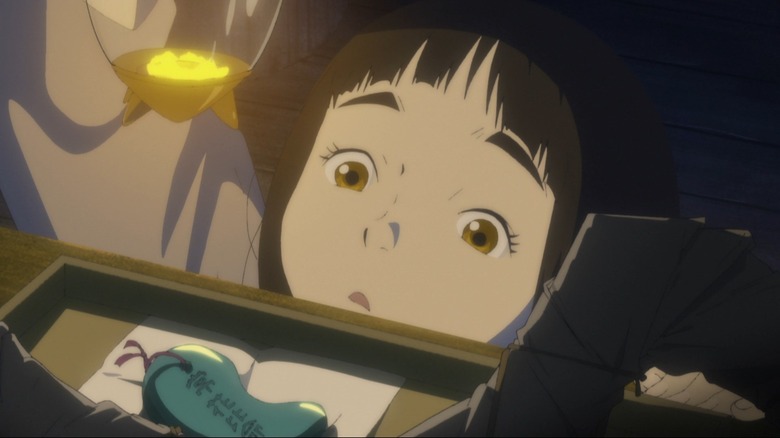
Spend enough time in anime fandom and you hear a common refrain: "They don't make shows like they used to anymore." Do they? There's plenty of great anime still being made: Fall 2022 alone brought an incredible bumper crop of anime series across multiple genres. Some may prefer the masterpieces of the past, but those masterpieces were exceptional even then. Even so, it is indisputable that certain kinds of anime are simply not made anymore. Original anime series are scarce. Modern shows rarely last beyond 12 or 13 episodes. Robots drawn in traditional 2D animation, outside of specialist studios like Trigger or Sunrise, are rare. Even the newest "Gundam" series, usually the industry standard for 2D giant robot shows, struggled weekly to maintain the standard of its mechanical animation. To find series like the long-running psychological thriller "Monster," or the slice-of-life mystery "Haibane Renmei," you have to go back 20 or 30 years in the medium's history.
At other times, though, the medium's history comes forwards 20 or 30 years to meet you. Such is the case with "The Fire Hunter," a fantasy saga set in a world where fire has been outlawed and hunters harvest the blood of fiends to power their machines. The first episode, which aired on January 14, 2023, is defiantly slow-paced. By its end, we have just barely met one of the main characters and have only caught a glimpse of another. Much of the time is spent watching people make paper, sell goods, and operate complicated machines in great detail. Modern audiences may be bored. But as far as I'm concerned, "The Fire Hunter" is 2023's fantasy series to beat.
Hound And Sickle
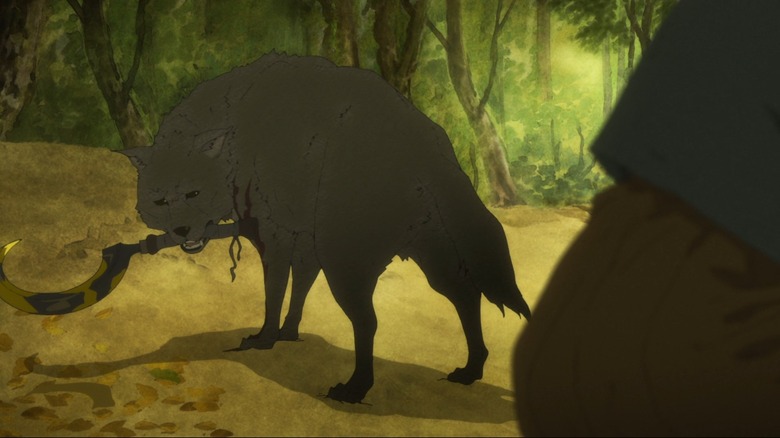
"The Fire Hunter" befuddles from its opening minutes. It starts in medias res with a scene of shocking violence. Past the opening credits, we follow a young woman named Touko as she is made to take responsibility for what has happened. While Touko expresses her anxiety through her body language and facial expressions, we never once hear what she is thinking. It's a choice that diverges from many anime series made today that rely on inner monologue, often adapted from manga and light novels. "The Fire Hunter" feeds the audience information through its dialogue, but the show often cuts to seemingly unrelated scenes, setting details, and hand motions. Following the story necessitates paying close attention to both tracks so as not to be lost.
A narrator is introduced 11 minutes in after making a brief appearance in the opening scene. But the narrator overwhelms the audience as often as she clarifies key details. "That night a man they call a 'fire hunter' died," she says in the beginning, "leaving behind only his hound and sickle." But why does a fire hunter, whatever that might be, need a hound or a sickle? Later, the narrator explains that "Once, humans could make fire and use it as they pleased. But then, the human race was remade." What? Some critics have taken "The Fire Hunter" to task for relying on a narrator at all, rather than allowing the characters and setting to speak for themselves. I partially agree, but at the same time a narrator is a tool like any other. The narrator of "The Fire Hunter" conveys a certain old-fashioned atmosphere, while maintaining tight control over what the audience knows and what they do not.
Fiend Blood
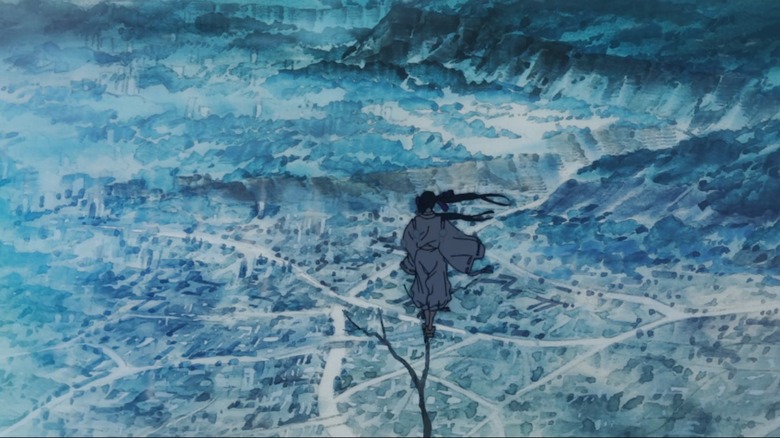
The aesthetics of "The Fire Hunter" are similarly rooted in the past. Touko's older family and neighbors are rendered fairly realistically. The first episode devotes far more time to their day to day lives than the slaying of the fiend that opens the series. In contrast to its naturalistic depiction of human society, the supernatural is captured in extremes -- the sickly yellow of fiend blood, the thick brush strokes of the slaying, and the fire that warps human bodies. When a fiend appears on screen, everything in the world moves constantly and unnaturally. By comparison, key moments in the lives of Touko and the show's second protagonist, Koushi, are rendered as illustrated "postcard memories" popularized by Osamu Dezaki. The turn from cool "stillness" to red-hot chaos is rarely seamless, but speaks to the story's greater worldview.
If "The Fire Hunter" is reminiscent of the work of older artists, that is because its creative team is made of older artists. The most famous of them is scriptwriter Mamoru Oshii, the famous director of "Ghost in the Shell" as well as much of the '80s classic "Urusei Yatsura." He is joined by a number of his friends and allies, including director Junji Nishimura and composer Kenji Kawai. Legendary voice actor and vocalist Maaya Sakamoto (of "Escaflowne" fame) sings the ending theme, while a shot in the opening credits of a woman standing on a tree branch is lifted directly from fantasy classic "Record of Lodoss War." It should also be noted that the illustrator for the original "Fire Hunter" novels, Akihiro Yamada, also drew the covers for the beloved fantasy novel series "The Twelve Kingdoms."
Fire On The Wind

Rather than Mamoru Oshii, I think Junji Nishimura represents a better gauge as to what to expect from "The Fire Hunter." Nishimura's output is wide-ranging and includes solid work, outright trash, and a handful of hidden masterpieces. His 2004 series "Windy Tales" is a visually astonishing slice-of-life series made at the prestigious Production I.G. But his 1996 fantasy adaptation "Violinist of Hameln" features so little movement that fans dubbed it "Slideshow of Hameln." Personally speaking, I suspect these two series are key to what "The Fire Hunter" is doing. The show's use of still images, pans, and pointed cutting around character face and bodily movement are reminiscent of the budget-saving tricks of "Hameln." At the same time, though, these decisions are evocative in their own right, building the world and atmosphere of "The Fire Hunter" through implication. Meanwhile, the animation during fiend sequences bear comparison to the stylization of "Windy Tales," even as they fail to match its technical expertise.
While I'm loving the series so far, I have to admit that Nishimura and Oshii are playing a dangerous game with "The Fire Hunter." Its detailed character designs, careful storyboarding, and elaborate world all require time and effort to maintain. These qualities are in short supply within today's overstretched anime industry. The show's studio, Signal.MD, was recently behind the disastrous adaptation of "Platinum End" (based on a series by the creators of "Death Note"). Even before that, though, the studio made the news when Japan's FTC caught them refusing to pay a subcontracted animator who worked for them in 2019. An environment like this could spell doom for "The Fire Hunter," even if its key creative staff are veterans.
Out Of The Past

I'll admit that my admiration for "The Fire Hunter" is rather selfish on my part. For the past several years, fantasy anime has been dominated by stories that borrow from Japanese role-playing games and MMORPGs. Many are sourced directly from webnovels, whose passionate authors often prioritize indulgence over originality. The protagonists hail from modern Japan, or are simply reborn in the bodies of local people. These stories aren't without their charms: "Mushoku Tensei" at least has great animation, while "So I'm a Spider, So What?" has a wild conceptual hook. (The protagonist is a spider!) Personally, though, I can't help but find these kinds of reincarnation stories to be cowardly. Rather than build a setting that speaks for itself, the majority of Japanese fantasy novels adapted into anime are masturbatory power fantasies coated in a thick layer of irony.
There have always been novels like "The Fire Hunter" being written in Japan. Manga translator Jocelyne Allen has been championing Chisato Abe's "Yatagarasu" stories for the past few years. More recently, Mizuki Tsujimura's "Lonely Castle in the Mirror" was adapted into a film in 2022. It's rare, though, that we see these stories make their way to TV outside of manga adaptations. "The Fire Hunter" may have only been possible due to Mamoru Oshii and Junji Nishimura's industry clout. The confidence with which it builds a world, and populates it with ordinary people living their lives in a fantastic setting, should not be a rarity in this industry. Yet "The Fire Hunter" remains just out of step, a relic of an earlier time when production companies would occasionally finance weird, slow-paced passion projects. I wish it came about in better circumstances, but I'm also grateful this old-fashioned tale exists at all.
Read this next: 10 Anime Movies That Deserved To Win The Oscar For Best Animated Feature
The post Why The Fire Hunter Is Your New Anime Obsession appeared first on /Film.
The Definitive Browser Security Checklist
New Open Source OT Security Tool Helps Address Impact of Upcoming Microsoft Patch
Industrial cybersecurity firm Otorio has released an open source tool designed to help organizations detect and address issues related to an upcoming update from Microsoft.
Otorio’s DCOM Hardening Toolkit, which is available for free on GitHub, is a PowerShell script that lists weak DCOM authentication applications installed on the tested workstation and provides functionality to address associated security issues.
The tool is useful for organizations that use the OPC Data Access (DA) protocol for communications between PLCs and software within OT networks. OPC DA relies on Microsoft’s Distributed Component Object Model (DCOM) technology, which can introduce serious vulnerabilities.
The newer OPC Unified Architecture (UA) protocol does not rely on DCOM so it’s not affected by the same security issues, but many industrial organizations still rely on OPC DA.
The problems that the Otorio tool aims to address are related to some changes that Microsoft has been making.
In 2021, Microsoft informed customers about CVE-2021-26414, a Windows server security feature bypass flaw. Addressing CVE-2021-26414 requires hardening DCOM, which could cause problems for some organizations using it and that is why Microsoft is gradually implementing changes. The goal is to give users enough time to check and resolve any compatibility issues.
The first updates were released by Microsoft in June 2021, with the DCOM hardening disabled by default. The second updates, released in June 2022, enabled the hardening by default, but allowed users to disable the changes manually.
The last updates, scheduled for March 2023, will keep the hardening enabled and users will not be able to disable it.
Otorio’s DCOM Hardening Toolkit can be used to learn whether an OT network includes unsecured DCOM that will become inoperable after the new update is rolled out in March, and it also provides remediation instructions.
“If a company applies the March patch and loses critical visibility and communication between nodes in its network, it could experience significant financial losses. Our goal is to prevent that kind of catastrophe,” said Yair Attar, CTO and co-founder of Otorio.
Otorio has also implemented the open source tool’s capabilities in its RAM² cybersecurity and digital risk management platform for OT.
Related: New Dragos OT-CERT Provides Free Industrial Cybersecurity Resources
Related: Open Source Tool Helps Organizations Secure GE CIMPLICITY HMI/SCADA Systems
Related: Open Source Tool Helps Secure Siemens PCS 7 Control Systems
The post New Open Source OT Security Tool Helps Address Impact of Upcoming Microsoft Patch appeared first on SecurityWeek.
CISA Provides Resources for Securing K-12 Education System
The US Cybersecurity and Infrastructure Security Agency (CISA) this week published a report detailing the cybersecurity risks the K-12 education system faces, along with recommendations on how to secure it.
Over the past four years, there have been thousands of cyber incidents involving K-12 institutions, where threat actors targeted school computer systems to deploy ransomware, disrupt access, render systems unusable, and steal sensitive information on students and employees, including financial and medical information, and employee Social Security numbers.
The K-12 Cybersecurity Act of 2021 instructed CISA to review the cyber risks to elementary and secondary school, evaluate challenges schools and school districts face in securing information systems, to provide recommendations on improving the protection of these systems, and to develop an online training toolkit for school officials.
Discussions with stakeholder groups relevant to the K-12 education community revealed that the majority of them do not have the time or resources to secure information systems and sensitive student and employee records, or to implement cybersecurity protocols.
“Most reported that the breadth of available cybersecurity information—news coverage, conference panels, webinars, and more—only made matters more complicated. Nearly all reported that they needed simplicity, prioritization, and resources targeted to the unique needs and context of K-12 organizations,” CISA’s report reads (PDF).
According to CISA, “with finite resources, K-12 institutions can take a small number of steps to significantly reduce cybersecurity risk,” such as deploying multi-factor authentication (MFA), patching known vulnerabilities, creating backups, and implementing cyber incident response plans and cybersecurity training programs.
The agency’s incursion into the cybersecurity stance of the K-12 education system has revealed that many school districts struggle with insufficient IT resources and cybersecurity capacity, which can be addressed by using free or low-cost services, by asking technology providers for strong security controls at no additional cost, by migrating IT services to more secure cloud versions, and by taking advantage of the State and Local Cybersecurity Grant Program (SLCGP).
CISA also notes that K-12 entities cannot singlehandedly identify and prioritize emerging threats, risks, and vulnerabilities, recommending that they join relevant collaboration groups, work with other information-sharing organizations, and collaborate with CISA and FBI regional cybersecurity personnel.
The agency recommends that all K-12 institutions start by investing in the most impactful security measures, which will allow them to eventually migrate to a mature cybersecurity plan. They should also prioritize investments in line with CISA’s Cross-Sector Cybersecurity Performance Goals (CPGs).
CISA’s Digital Toolkit contains resources and materials in line with these recommendations, as well as guidance on how stakeholders can implement each recommendation. The toolkit also includes additional resources to help stakeholders build, operate, and maintain a resilient cybersecurity program at their institution.
Related: CISA Updates Infrastructure Resilience Planning Framework
Related: CISA Releases Decision Tree Model to Help Companies Prioritize Vulnerability Patching
Related: CISA Urges Organizations to Implement Phishing-Resistant MFA
The post CISA Provides Resources for Securing K-12 Education System appeared first on SecurityWeek.
16 Post-Apocalyptic TV Shows, but Zombies Had Nothing to Do With It

Though end-of-days narratives date back to ancient Mesopotamia at least, the pop culture of past few decades has us convinced there’s at least a 70% chance the apocalypse will specifically involve hordes of shambling undead. When it comes to the final days, it’s mostly George Romero’s world; we’re just all dying in…
Star Trek's Spock Was Always At His Best When He Was A Little Less Human
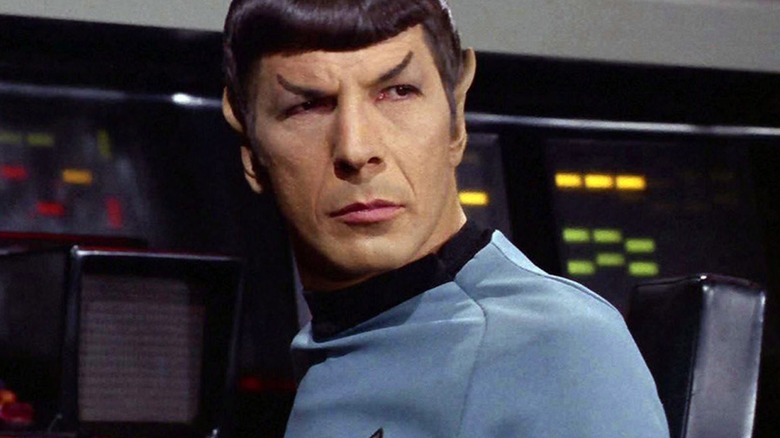
The original "Star Trek" pilot, "The Cage," did a wonderful job of establishing the tone of the series, and the types of strange, psychological crises that the characters on it would regularly encounter. Jeffrey Hunter played the short-tempered and serious Capt. Pike, and Majel Barrett played his first officer, only referred to as Number One. It wouldn't be until "Star Trek: Strange New Worlds" in 2022 that Number One's name, Una Chin-Riley, would be mentioned on screen. The original pilot for "Star Trek" was ultimately rejected, and most of the show's original elements were retooled. It wasn't until the second pilot, "Where No Man Has Gone Before," that the best-known 1966 Trek ensemble would be established. The only things that were carried over were the technology, the Starfleet symbols, the name of the U.S.S. Enterprise, and the character of Spock (Leonard Nimoy).
Spock, a half-human, half-Vulcan science officer, was the most striking, eye-catching character on the young show. Sporting pointed ears and angled eyebrows, he was just alien enough to get viewers' attention. He also behaved strangely. In the lore of "Star Trek," Vulcans have rejected the cultivation of their emotion, choosing instead to focus on the all-encompassing power of scientific logic. As such, Spock often spoke coldly, rejecting the impassioned ravings of his human co-workers, and striking a good balance with the frequently angry Dr. McCoy (DeForest Kelley) and the instinctual, level-headed Capt. Kirk (William Shatner). A common interpretation of the three credited leads of "Star Trek" is that of mind (Spock), body (McCoy), and soul (Kirk). Or, for the Freudians, id, ego, and superego.
Whatever the interpretation, though, Spock is a vital linchpin in the series' popularity. One might fairly call him the most important character in "Star Trek."
Don't Knock The Spock
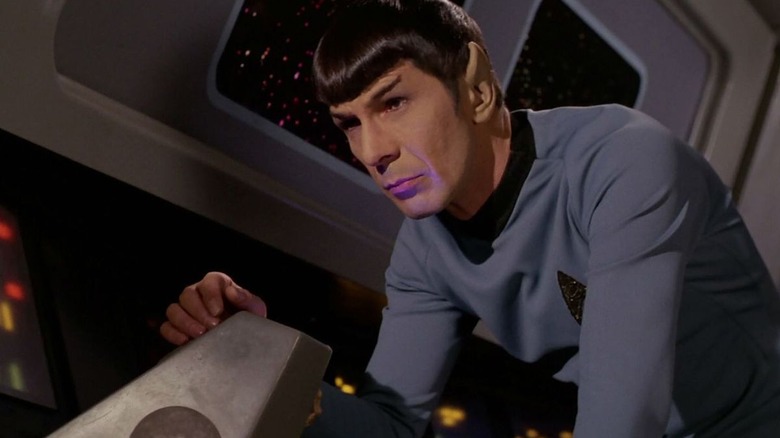
There might be some debate, however, as to what Spock's central appeal is. In speaking to other Trekkies, I've encountered several people who prefer Spock as he behaved in the episode "Amok Time" (September 15, 1967), the first episode of the show's second season. In "Amok Time," Spock revealed that his species experiences a peculiar seven-year itch called pon farr, an instinctual mating drive that transformed otherwise staid Vulcans into angry, horny monsters. The climax of the episode will see Spock fighting Kirk to the death over who gets to mate with the Vulcan T'Pring (Arlene Martel). When Kirk cleverly eludes murder, Spock is elated to see him alive. He even smiles. "Amok Time" saw the stalwart Spock feel rage, lust, embarrassment, joy ... the whole gamut of emotions.
Fans of "Amok Time" like to point out that Spock, in being half-human, is just as prone to impulses and passions as the very human audience watching him. They might find comfort in the fact that even a weird, emotionless alien is relatable and vulnerable. Some enjoy watching their powerful heroes humanized, and that's what "Amok Time" does.
Personally, the above-stated appeal of "Amok Time" has never sat well with me. While I can appreciate Spock's rage from a storytelling perspective and enjoy the expansion of Vulcan society within the Trek mythos at large, I took no pleasure in watching Spock break into a fit of rage or an uncontrolled smile. For many, Spock's power came from his stalwart inability to crack. Indeed, the counterargument could be made that Spock's central appeal is not his humanity, but his Vulcan-ness. It's when Spock is faced with an extreme scenario and doesn't succumb to emotional pressure that he becomes more interesting and admirable.
Spock's Command Skills
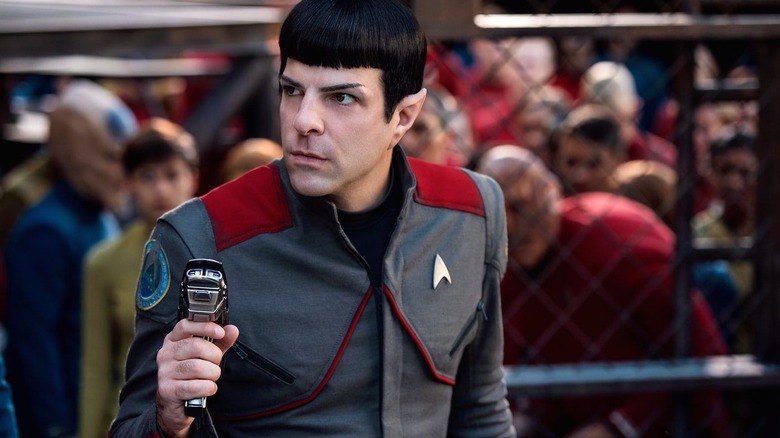
One might look to the episode "The Galileo Seven" (January 5, 1967) as a counterpoint to "Amok Time." In that episode, Spock and several other human crewmates were forced to crash their shuttlecraft, the Galileo, on an unvisited planet called Taurus II. The local inhabitants are a species of 10-foot cavemen that kill a few of the crewmembers with spears and begin smashing boulders into the shuttle. Spock, the commanding officer, attempts to logic his way out of a desperate situation, with imperfect results. He, however, doesn't give in to bloodlust, revenge, or panic like the people around him. He stays in character, even when the situation might have inspired a more emotional response, and is all the more admirable for remaining who he is and relying on his strengths.
"The Galileo Seven" also reveals that Spock may not be the best commanding officer. If one seeks humanizing flaws, one can easily point out that Spock falters when outside of his scientific, analytical wheelhouse.
Spock's inability to "break" might serve as the blueprint for the general professionalism that remains pervasive throughout the franchise. "Star Trek" is, we here remind ourselves, a workplace drama foremost, featuring uniformed characters who are on the clock. A general thrust of "Star Trek" is that everyone has a job they're devoted to, and they try to do as well as they can. "Star Trek" is aspirational in that regard, depicting a multicultural workplace where everyone's strengths are respected. Spock was the acme of Starfleet probity. He kept calm, even as the job became stressful.
Except for that time he was played by Zachary Quinto and wailed on a guy's face with his fists.
The Passionate Vulcan
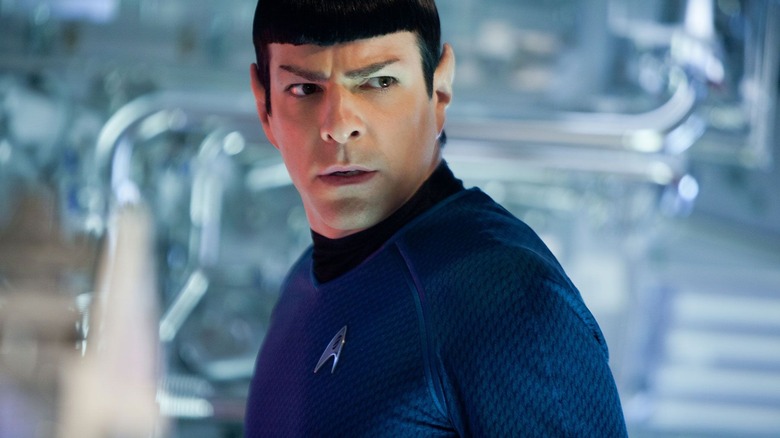
The ethos of J.J. Abrams' rebooted "Star Trek" film series (2009 - 2016) was that the crew — in a parallel universe — were younger and more impulsive than previously seen and hence more prone to youthful emotional outbursts. As such, Spock (Quinto) was sexually passionate with Uhura (Zoe Saldaña) and, in "Star Trek Into Darkness," given to wrath. When Khan (Benedict Cumberbatch) attacked the Enterprise and caused Kirk (Chris Pine) to die, Spock flew into a rage, chased down his attacker, and pounded his face repeatedly on the roof of a speeding space-van. In terms of action movie shlock, I suppose this is typical for the genre. In terms of "what Spock would do," it felt very, very wrong. Perhaps fans of "Amok Time" enjoyed watching Spock become a violent a-hole. Others, meanwhile, remembered that Spock was once known for logic and diplomacy and had trouble connecting extant Trek knowledge with the hockey goon on screen.
Watch "Into Darkness" and the "Star Trek: The Next Generation" two-parter "Unification" (November 4 and 11, 1991) back-to-back sometime, and experience the most violent form of pop culture whiplash since "Highlander 2: The Quickening." In "Unification," Spock (Nimoy) is as logical as he has always been, and speaks openly about the hard work required to achieve justice and force society to grow. Not once does he beat a guy's face in on the top of a van.
The latest iteration of Spock, as played by Ethan Peck on "Star Trek: Discovery" and "Star Trek: Strange New Worlds" is striking something of a fair balance between Amok Spock and Galileo Spock.
New Spock
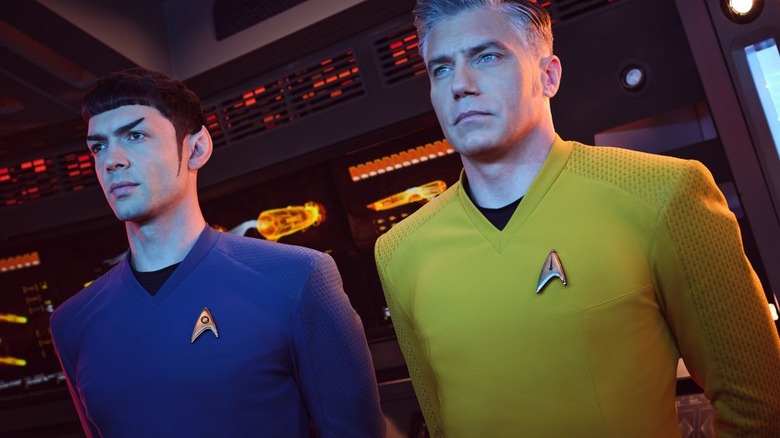
On the one hand, the character is finally allowed back into a professional setting, having to behave professionally among his fellow crewmates. On the other hand, T'Pring (Gia Sandhu) now plays a larger role in his life, and the two of them are openly sexually attracted to one another. They speak in cold terms, but their twinkly eyes and frequently nude bodies speak to other interests. Peck plays Spock with a mild smirk, giving the character a human, bemused quality, even as he speaks coldly and behaves logically. This blend is appealing to many fans of the show.
To reiterate, however, Spock is always going to be more appealing the more logical, the more alien, and the more Vulcan he is. There are viewers who look to Spock as an aspirational figure. Indeed, those who are on the autism spectrum or who are merely socially awkward can hold Spock up as a character who is refreshingly free of bothersome traditional social interactivity. Essays by people wiser than myself have been written about Spock's status as an autistic character, and how he might serve as a positive representation of neurodivergence. The fact that he operated by his own scientific code and regularly rejected (or was befuddled by) the dangerous emotional whims of people around him made him inspiring. He was emotionless, yes, but was never anything less than heroic, intelligent, and a vital member of the crew.
Indeed, it was when he did show emotions that the ship was in trouble. Emotional Spock was a sign of danger. A signal that something had broken. When Spock has everything under control — and he very often had everything under control — we knew we were safe and that everything was right with the universe.
Read this next: 12 Reasons Why The Original Series Is The Best Star Trek Show
The post Star Trek's Spock Was Always At His Best When He Was a Little Less Human appeared first on /Film.
The 15 Best Comedy Movies From Black Directors
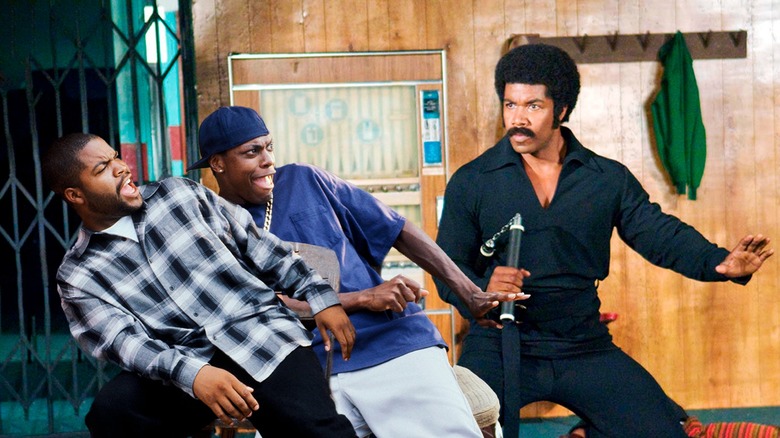
There have been many classic movie comedies over the years featuring Black stars, ranging from Eddie Murphy's Coming to America to Whoopi Goldberg's Sister Act. Those films are among the many that resonated with Black audiences even though they were directed by white filmmakers (John Landis and Emile Ardolino, respectively, in the case of those two movies). Despite that, Hollywood has also had a long tradition of Black directors creating movies aimed specifically at Black audiences; trailblazer Oscar Micheaux, in fact, is regarded as the first major Black filmmaker, directing and producing more than 40 so-called "race films" between 1919 and 1948.
These days, as Hollywood executives increasingly come to realize the importance of Black directors telling Black stories, there's been an ever-growing number of Black directors engaging in big-screen filmmaking, a trend that has been evident not just in dramas but in comedies as well. In fact, some of the most beloved comedies with predominantly Black casts featured Black directors at the helm. For the full picture, keep on reading for a rundown of the 15 best comedy movies from Black directors
She's Gotta Have It (1986) - Directed By Spike Lee
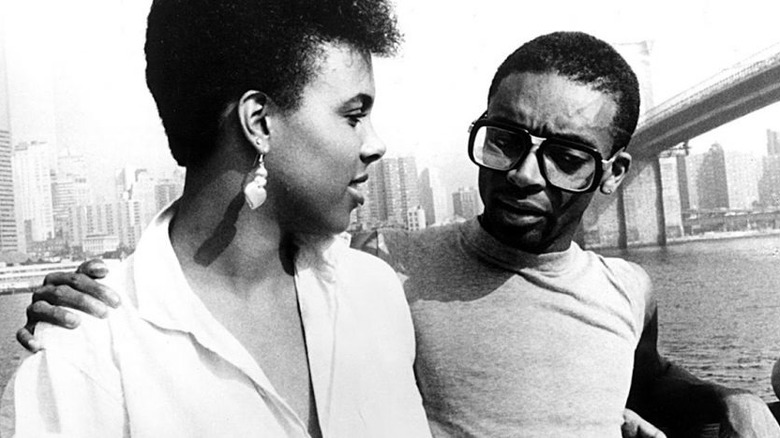
She's Gotta Have It heralded the arrival of a new voice in cinema, the first film from now-iconic filmmaker Spike Lee. Made on a shoestring budget of $175,000, the film follows the romantic conundrums surrounding young, attractive New Yorker Nola Darling (Tracy Camilla Jones), who is simultaneously dating three very different men: sensitive and caring Jamie Overstreet (Tommy Redmond Hicks), narcissistic male model Greer Childs (John Canada Terrell), and basketball-obsessed bicycle messenger Mars Blackmon (played by Lee himself). Nola's free-thinking, sexually liberated attitudes take a hit when all three men meet and compare notes about their respective relationships/experiences with Nola, leading her to some unexpected soul-searching.
More correctly categorized as a dramedy than a straight comedy, She's Gotta Have It's funniest bits come courtesy of Lee's character and his hilarious mile-a-minute chatter. That's evident from what is arguably the film's most memorable moment: when Mars calls up Nola for a birthday booty call. She blows him off (because she's in bed with Jamie), leading Mars to beg, "Please, baby, please, baby, please baby, baby, please." When he's rebuffed, Mars is then seen phoning another woman to make the same request. Lee revisited his first project in 2017 with the Netflix series She's Gotta Have It, which updated the concept to the present, casting new actors as Nola and her trio of suitors.
Hollywood Shuffle (1987) - Directed By Robert Townsend
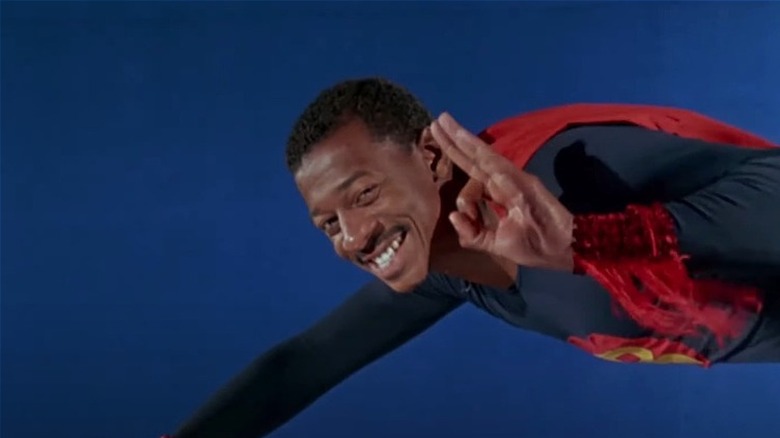
Written, produced, directed by, and starring Robert Townsend, Hollywood Shuffle is a prime example of the old axiom advising to "write what you know." In this semi-autobiographical indie comedy, Townsend — an up-and-coming actor at the time — plays aspiring actor Bobby Taylor, who auditions for one stereotypical role after another while paying the bills by working at Winky Dinky Dog. Bobby figures his big break has arrived when he's cast in the street-gang flick Jivetime Jimmy's Revenge, but finds himself having a crisis of conscience about accepting the stereotypical-bordering-on-insulting role, and he eventually quits to save his dignity.
The film's funniest bits come during Bobby's fantasy dream sequences, which function as comedy sketches within the film. In one, he envisions an acting school that specializes in teaching Black thespians how to be "more Black," while another spoofs the then-popular film review show At the Movies, substituting the show's stars — movie critics Gene Siskel and Roger Ebert — with two Black guys who sneak into cinemas to review such faux films as Chicago Jones and the Temple of Doom and Attack of the Street Pimps before they're thrown out of the theater by an usher. After spoofing At the Movies, Townsend ironically wound up receiving a thumbs-up review from Ebert, who acknowledged the low-budget indie's problems while also offering praise: "There are a lot of good laughs in Hollywood Shuffle, and the movie certainly functions as a showcase for Townsend ..."
I'm Gonna Git You Sucka (1988) - Directed By Keenen Ivory Wayans
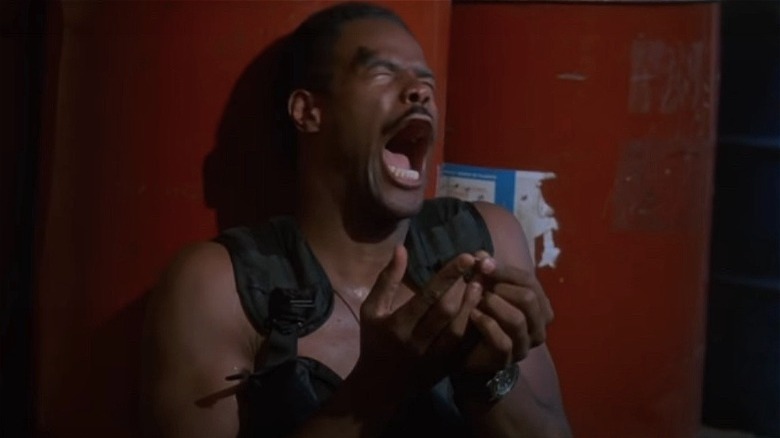
One of Hollywood Shuffle's co-writers was Keenen Ivory Wayans, who made his directorial debut with I'm Gonna Git You Sucka, which he also wrote and starred in. As the title suggests, the film is a spoof of 1970s blaxploitation films such as Shaft, Super Fly, and Rudy Ray Moore's Dolemite. Wayans plays Jack Spade, a military veteran who returns to his hometown to discover his younger brother, Junebug, has died from an "OG" — an overdose of gold chains. Realizing gold chains have become an epidemic plaguing the neighborhood, Jack makes it his mission to bring down Mr. Big (John Vernon, a.k.a. Animal House's Dean Wormer), the crime boss at the top of the gold chain empire. Understandably, the comedy is big, broad, and silly, and it ultimately paved the way for Wayans' subsequent success on the small screen with his FOX sketch-comedy series In Living Color.
The first-rate cast is also a contributing factor to the film's funniness. In addition to actual blaxploitation stars Isaac Hayes, Jim Brown, and Antonio Fargas, Wayans wrangled several of his hilarious siblings, as well as Clarence Williams III of Mod Squad fame, future In Living Color star David Alan Grier, and up-and-coming comedians Robin Harris and Chris Rock.
House Party (1990) - Directed By Reginald Hudlin
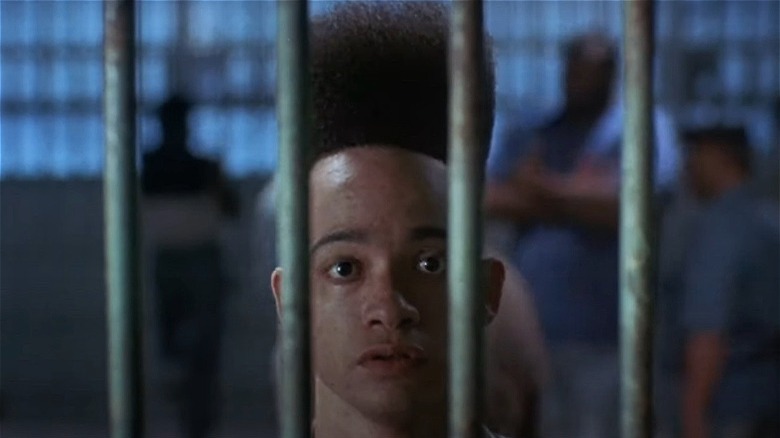
Ostensibly a vehicle for then-popular rap duo Kid 'n Play (a.k.a. Christopher "Kid" Reid and Christopher "Play" Martin), House Party marked the directorial debt of Reginald Hudlin, who would go on to direct such films as the Eddie Murphy-starring Boomerang and the Matthew Perry rom-com Serving Sara). Essentially high school hijinks, the plot focuses on a party that Play throws when his folks are out of town for the weekend. Because Kid has been grounded, he sneaks out but eventually incurs the wrath of his angry dad (comedian Robin Harris, who steals every scene he's in). Getting to the party, however, is easier said than done, with Kid encountering a variety of obstacles (including a brief stint behind bars) before finally making it to the big bash.
The low-budget film made its money back and then some, ultimately raking in more than $26 million — 10-plus times the $2.5 million it cost to make. That led to sequels, 1991's House Party 2 and 1994's House Party 3, and the 2023 House Party remake. What set House Party apart from other Black-centric comedies at that time was its authenticity. "The theory we've always believed ... is that if you can make a film that is culturally uncompromised, it will still have broad appeal," Hudlin told the Los Angeles Times back in 1990. "And, in fact, by diluting the [ethnic content of] the film, it becomes less interesting for all audiences."
Friday (1995) - Directed By F. Gary Gray
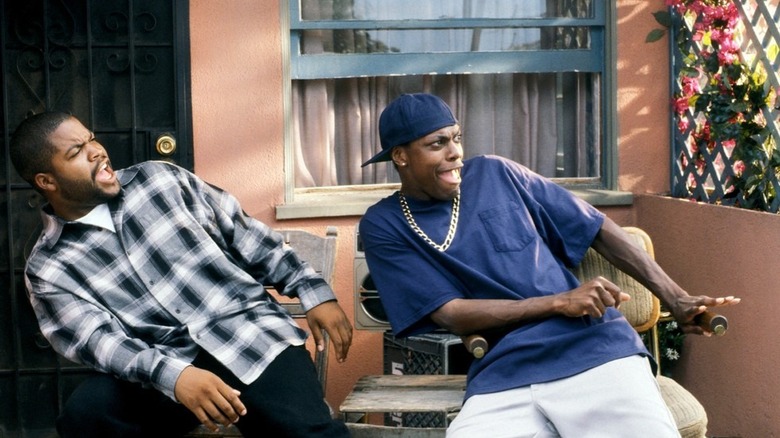
F. Gary Gray was best known for directing music videos for the likes of Cypress Hill, Coolio, and Ice Cube when he made his directorial debut with Friday. The screenplay — co-written by the film's star, Ice Cube, and DJ Pooh — is a classic buddy comedy with a stoner twist, following the exploits of weed-loving slacker duo Craig Jones (Ice Cube) and Smokey (Chris Tucker) during one day in South Central. Their day turns bleak, however, when the two are given until that evening to repay $200 to drug dealer Big Worm (Faizon Love) for the weed they were supposed to sell but instead smoked, or they'll be whacked. Thanks to that ultimatum, the film follows their mishaps trying to scrape together the $200. Along with the two leads, Friday benefits from a top-notch cast playing an array of colorful characters, ranging from comedian Bernie Mac as not-so-godly Pastor Clever to annoying Felicia (Angela Means), the latter spawning the wildly popular meme "Bye, Felicia."
According to the film's star/screenwriter, his intent was to show the lighter side of Black neighborhoods after the starkly gritty depictions in Boyz n the Hood and its ilk. "I mean, I knew it was crazy around where I grew up but we had fun in the hood," Ice Cube told Complex, recalling that they based the film's characters on the real people they knew. "Every hood has a Deebo or a Felicia," explained DJ Pooh.
Don't Be A Menace To South Central While Drinking Your Juice In The Hood (1996)- Directed By Paris Barclay
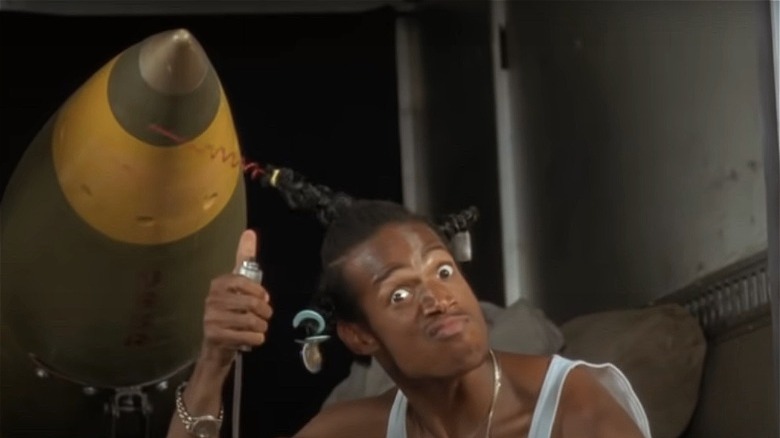
While Friday may have been a reaction to all those gritty hood-set dramas, Don't Be a Menace to South Central While Drinking Your Juice in the Hood is a straight-out genre parody. Taking his cues from the over-the-top, absurdist antics of Airplane, director Paris Barclay shifted gears from directing music videos and TV shows to his first feature film. The sibling duo of Shawn and Marlon Wayans starred as, respectively, Ashtray — sent by his mother to live in the ghetto so he can toughen up — and Loc Dog, his drug-dealing, weapons-loving, criminal cousin.
Among the film's most memorable characters are: Officer Self Hatred (Bernie Mac), a Black cop who only harasses Black people; demon-possessed Keisha (Terri J. Vaughn); Dashiki (Tracey Cherelle Jones), a "hood mother" who has seven kids by seven different fathers; Crazy Legs (Suli McCullough), who dreams of becoming a professional dancer despite having been paralyzed in a drive-by shooting; and Malik, played by Omar Epps as a parody of the character he portrayed in Higher Learning. Keenen Ivory Wayans also appears as a mailman who pops up whenever a lesson is being imparted to the audience so that he can hammer it home even further by yelling, "Message!" Sometimes, those messages become the setup for a joke — like when Ashtray tells a young Black boy that they're an endangered species "Why, because we're Black males?" the boy asks. "No," Ashtray responds, "because rappers are taking all the good acting jobs."
Barbershop (2002) - Directed By Tim Story
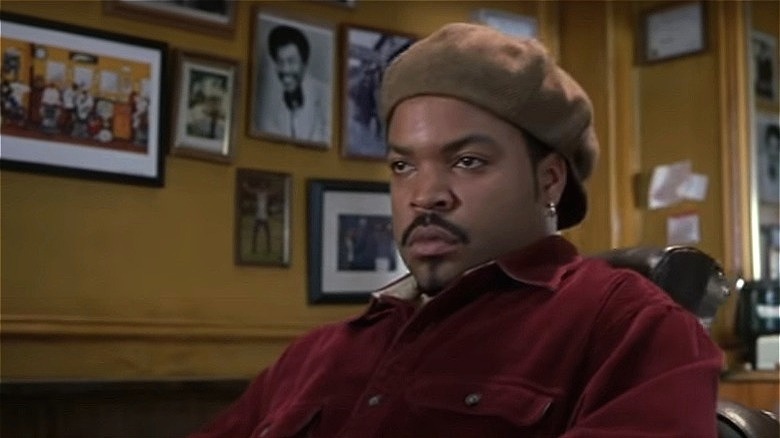
As an actor, Ice Cube has displayed the rare ability to excel in both gritty drama and outrageous comedy. Building on the success of Friday, he took the lead role of Calvin Palmer in director Tim Story's Barbershop, set in a Black barbershop on the South Side of Chicago. The film explores the role of the barbershop in Black communities, as a gathering place for men to come together and get their hair trimmed — but mostly to share stories and engage in hilarious conversations. On that front, the film's funniest utterances come from veteran barber Eddie, played by comedian Cedric the Entertainer, whose old-school opinions may be out of step with the times, but nevertheless contain a certain wisdom, skewed as they may be. "There are three things that Black people need to tell the truth about," Eddie opines in one scene. "Number one: Rodney King should've gotten his ass beat for being drunk in a Hyundai in a white part of Los Angeles. Number two: O.J. did it! And number three: Rosa Parks didn't do nuthin' but sit her Black ass down!"
Made for a modest $12 million, Barbershop brought in more than $77 million at the box office. That success led to three sequels (including the Queen Latifah-starring Beauty Shop), establishing one of the most successful Black-led comedy movie franchises in Hollywood history.
Undercover Brother (2002) - Directed By Malcolm D. Lee
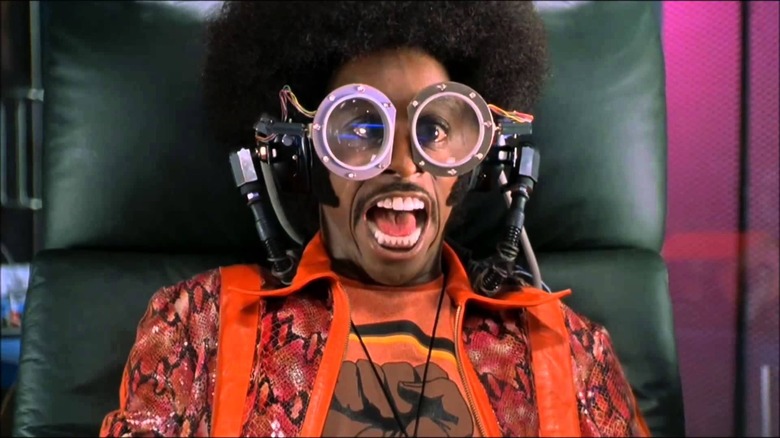
Based on writer and director John Ridley's animated online series, director Malcolm D. Lee's Undercover Brother spoofs both blaxploitation movies and the spy genre. Eddie Griffin stars as Anton Jackson, whose crime-fighting alter ego Undercover Brother joins the top-secret espionage agency known as B.R.O.T.H.E.R.H.O.O.D., which exists to thwart the devious efforts of The Man, leader of a Caucasian cabal devoted to the denigration of Black culture. Undercover Brother works under the organization's boss, the Chief (Chi McBride), alongside fellow agents Conspiracy Brother (Dave Chappelle), Smart Brother (Gary Anthony Williams), Sistah Girl (Aunjanue Ellis), and Lance the Intern (Neil Patrick Harris), the sole white member of the group. "What can I tell you, man," sighs the Chief while explaining Lance's presence. "Affirmative action." Undercover Brother and his cohorts must foil an evil plot after The Man's henchman, Mr. Feather (SNL alum Chris Kattan), kidnaps James Brown (with the Godfather of Soul playing himself). Other stars include Billy Dee Williams as a Colin Powell-esque general and Denise Richards as henchwoman She-Devil, who ultimately betrays The Man after falling for Undercover Brother's seductive charms.
"The picture is crammed with shameless satire, engaging moments of pure silliness and jokes that border on the outrageous," wrote critic Mick LaSalle of the film in his review for the San Francisco Chronicle. "It combines relentless energy with an aura of good nature for a formula that works."
White Chicks (2004) - Directed By Keenen Ivory Wayans
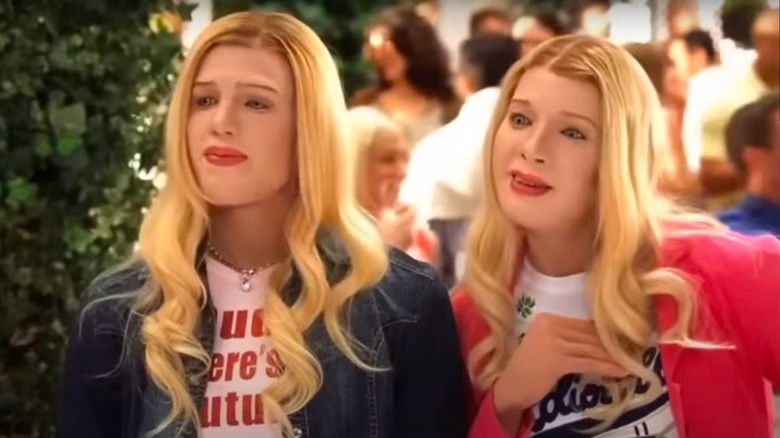
Keenen Ivory Wayans returned behind the camera for the 2004 comedy White Chicks, which boasted an outrageous premise. Wayans' brothers, Marlon Wayans and Shawn Wayans, star as Marcus Anthony II and Kevin Copeland, respectively, low-level FBI agents who badly botch a case — but are offered one last chance to rescue their careers by protecting the daughters of a wealthy cruise line owner from becoming the latest victims in a string of kidnappings. When an unfortunate accident leads the women to suffer facial injuries and they refuse to be seen in public, the agents don makeup and wigs in order to impersonate them at a posh charity party.
At the time of its release, reviews for White Chicks were decidedly mixed. "Most movies require some suspension of disbelief," wrote critic Dave Kehr in his brutal review for the New York Times. "But White Chicks ... requires something more radical than that. A full frontal lobotomy might be a good place to start." The film also had its supporters. Variety reviewer David Rooney, for example, wrote, that "as lowbrow comedies go, it pretty much delivers." While the film was nominated for five Razzies — including Worst Picture — it also raked in an impressive box-office take of more than $113 million, and over the years has come to be considered a comedy cult classic.
Black Dynamite (2009) - Directed By Scott Sanders
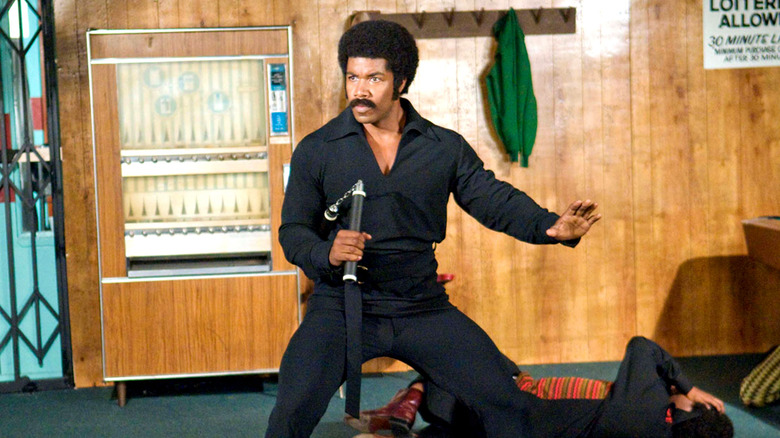
It's no secret that the blaxploitation films of the 1970s have been lovingly and hilariously spoofed in subsequent years, and director Scott Sanders' Black Dynamite is a worthy addition to that list. Michael Jai White stars as the titular Black Dynamite, a Vietnam vet, ex-CIA agent and kung fu expert whose mission to avenge the murder of his brother uncovers a vast conspiracy involving a malt liquor that's been infused with a nefarious chemical that shrinks the genitals of those who drink it. Sanders and White co-wrote the screenplay, with White revealing in an interview with The A.V. Club that he came up with the idea for Black Dynamite while listening to the James Brown classic "Super Bad," and that the character was initially intended to be named Superbad (a notion that the 2007 release of teen comedy Super Bad kiboshed).
While the film has frequently been compared to fellow blaxploitation spoofs I'm Gonna Git You Sucka and Undercover Brother, Black Dynamite is set in the 1970s, not the present, lending a level of authenticity that makes the absurdity of its gags hit even harder. Nowhere is that more apparent than in the film's action-packed climax, when Black Dynamite enters the Oval Office to engage in a mano-a-mano nunchuks battle with Richard Nixon — a scene that also features a cameo from the ghost of Abraham Lincoln.
Dear White People (2014) - Directed By Justin Simien

Rarely has social satire and hilarious humor blended as successfully as in Dear White People, the 2014 directorial debut of Justin Simien, who also wrote the screenplay. Set in fictional Winchester University, a prestigious Ivy League college, Samantha White (Tessa Thompson) ruffles feathers with her campus radio show Dear White People, in which she discusses the racism that the school's minority of Black students encounter at the predominantly white institution. Tyler James Williams (of Everybody Hates Chris fame) plays Lionel Higgins, a gay Black student who becomes conflicted when he's tapped by the college's student newspaper to write about Sam and his own impressions of being a Black student at Winchester. Ultimately, the simmering racial tensions on campus are brought to a head when a well-connected white student hosts a party encouraging white guests to wear blackface.
The film was met with critical acclaim and rave reviews, such as National Newspaper Publishers Association reviewer Dwight Brown's contention that the film is "a brilliant piece of writing from a very thoughtful and humorous director whose take on life is as fresh as the ink on a college diploma." Simien later expanded on the film's premise with the Netflix series Dear White People, which ran for four seasons.
Girls Trip (2017) - Directed By Malcolm D. Lee

Female-fronted comedy movies were once a rarity, and female-fronted comedies with Black leads were even rarer. Malcolm D. Lee (who brought viewers Undercover Brother) delivered a female buddy comedy for the ages with Road Trip, assembling an all-star cast featuring Queen Latifah, Jada Pinkett Smith, Regina Hall, and newcomer Tiffany Haddish. The four women play pals — who dubbed themselves the Flossy Posse — who have drifted apart over the years, but make an effort to reinforce their four-way friendship with a trip to the Essence Music Festival in New Orleans. It's there that Queen Latifah's character — a lifestyle guru fashioning herself as "the next Oprah" — will be giving a speech. Raunchy, drunken hijinks ensue, particularly in one scene in which the women imbibe absinthe, sending them all into a hilariously hallucinogenic frenzy.
Not only was Girls Trip beloved by critics, audiences felt the same way, propelling the film to a worldwide box-office gross of $140 million. Meanwhile, Girls Trip also served as a cinematic calling card for Haddish, whose breakout role as outrageous Dina sent her comedy career into the stratosphere.
Sorry To Bother You (2018) - Directed By Boots Riley
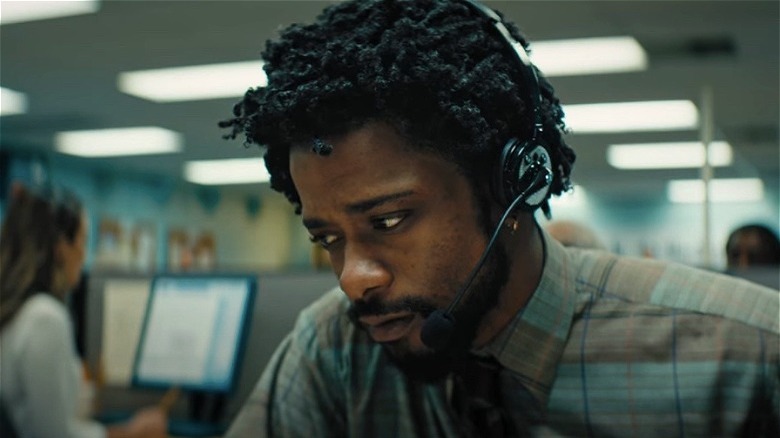
In Sorry to Bother You, the feature film debut of director Boots Riley, Lakeith Stanfield (a standout in FX series Atlanta) stars as Cassius "Cash" Green, who lands a low-level job as a telemarketer. Initially struggling, Cash discovers the secret to success by imitating a "white voice" in his calls (comedian David Cross provides that particular voice) that results in a major promotion to the position of Power Caller. This success, however, leads him to discover the company he works for is involved in shady arms deals fueled by slave labor; employees are given a substance that transforms them into human-horse hybrids dubbed Equisapiens. Cash faces a crisis of conscience, but also enjoys the sleek new apartment and expensive sports car that are among the perks of his promotion — until he discovers he too is morphing into an Equisapien.
If that sounds like a weird and bizarre morality tale, that's because it's how Riley intended it. "This is an absurdist, dark comedy with magical realism and science fiction inspired by the world of telemarketing," Riley told NPR's Fresh Air when asked to offer a brief synopsis.
Little (2019) - Directed By Tina Gordon
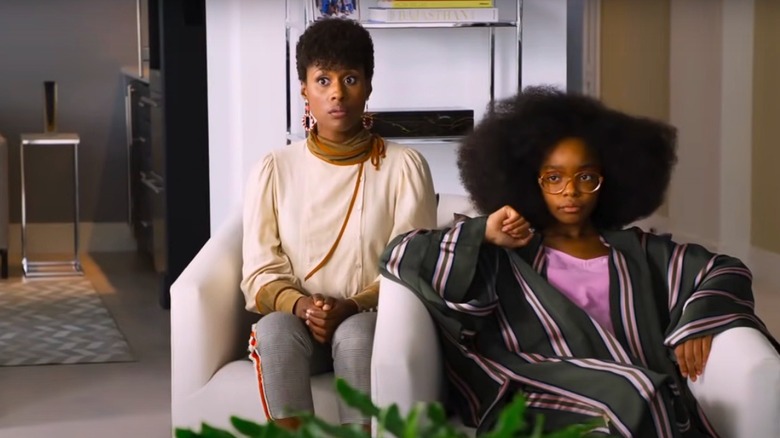
There have been many variations on the body-swap premise best evinced by the Tom Hanks classic Big, in which a child morphs into an adult version of themselves (also think Jennifer Garner's 13 Going on 30). Little presents a role reversal of Big, which is evident in its title, with Regina Hall playing high-powered tech executive Jordan Sanders, who transforms into her childhood self (Marsai Martin of Black-ish), with Issa Rae (Insecure) costarring as Jordan's incredulous best friend. Interestingly enough, it was Martin — then just 10 years old — who came to producer Kenya Barris (her boss on Black-ish) after watching Big, and at 14 wound up becoming an executive producer on the project — the youngest EP in Hollywood history. Tina Gordon (who wrote the screenplays for such films as Drumline and ATL) was tapped to make her directorial debut (as well as co-write the screenplay with Tracy Oliver).
The fact that Little was directed by, written by, and starred Black women is something of a milestone. And while several critics found the film too reminiscent of other body-swap comedies (and claimed it could have benefited from a bit more of Hall), Gordon moves the film along at a fast pace and keeps the comedy coming consistently.
The Forty-Year-Old Version (2020) - Directed By Radha Blank

If Little was significant for being led by Black women both in front of and behind the camera, The Forty-Year-Old Version can almost be seen as something of a companion piece. This 2020 comedy, directed by and starring Radha Blank (who also wrote and produced), depicts the struggles of playwright/teacher Radha as she approached her 40th birthday. Reflecting on the "30 under 30" award she won a decade earlier, she's forced to compromise the vision for her latest play, Harlem Ave., when the play's producer — an old white guy (Reed Birney) — insists she make changes that he feels will appeal to a white audience. In the midst of this, she rediscovers her long-lost passion for rap music, eventually rebranding herself as rapper RadhaMUSPrime. Ultimately, her newfound focus on music serves to reignite the creativity that she felt had stagnated, providing the inspiration that's been lacking from her play — and her life — and showing her a new path forward.
Blank's unique voice shines through The Forty-Year-Old Version, a powerful cinematic debut that earned a Grand Jury Prize nomination at Sundance, and the acclaimed film fest's Best Directing prize. Shooting the film in lush black-and-white, Blank explained in an interview with Thrillist, was inspired by her own cinematic influences. "It definitely was paying homage to these older New York City films, from Manhattan to The Apartment to She's Gotta Have It," she said.
Read this next: A Brief History Of Black Filmmakers
The post The 15 Best Comedy Movies From Black Directors appeared first on /Film.
Hackers Demand $10M From Riot Games To Stop Leak of 'League of Legends' Source Code
Read more of this story at Slashdot.
10 Professional Kitchen Tools I Use in My Home Kitchen

One of the pillars of success for working in a professional kitchen is “Do as much as you can in as few steps as possible.” The fact is, you don’t have the time for any extra or redundant steps; every move has to be purposeful, as well as the quickest option available. That’s why many tools in professional kitchens…
Senator Manchin aims to close battery loophole around the $7,500 EV tax credit
Senator Joe Manchin, chairman of the Senate Energy and Natural Resources Committee, has introduced a new bill that squashes a small loophole around the Inflation Reduction Act's (IRA) $7,500 EV tax credit. The new credits are restricted to cars with final assembly in the US, as well as those with a certain amount of North American battery content (an amount that increases every year). But, the U.S. Treasury has delayed its final rules on battery guidance until March, which means EVs with foreign batteries can still receive the full $7,500 in credits until then. Manchin's legislation, dubbed the American Vehicle Security Act (AVSA), would push the battery requirement back to January 1st.
“It is unacceptable that the U.S. Treasury has failed to issue updated guidance for the 30D electric vehicle tax credits and continues to make the full $7,500 credits available without meeting all of the clear requirements included in the Inflation Reduction Act," Manchin wrote a statement. "The Treasury Department failed to meet the statutory deadline of December 31, 2022, to release guidance for the 30D credit and have created an opportunity to circumvent stringent supply chain requirements included in the IRA. The IRA is first-and-foremost an energy security bill, and the EV tax credits were designed to grow domestic manufacturing and reduce our reliance on foreign supply chains for the critical minerals needed to produce EV batteries."
If it's passed, the bill would be disappointing news for anyone who rushed out to buy an EV before March (something plenty of car publications were suggesting). As Autoblog notes, the AVSA doesn't touch on the other IRA loophole, which also allows for the full credit for leased cars built outside of the US. But given Manchin's early obstruction to the IRA, as well as his push against lax battery rules, it wouldn't be surprising to see another bill in the works.
Boosteroid is the latest cloud gaming service to be optimized for Chromebooks
Booosteroid, a popular service that lets you enjoy high-end video games from the cloud through remote gaming desktops, is now optimized for ChromeOS. You can it out today on any Chromebook as a Progressive Web App, and for those that are new, a one-month trial is also available, but just for Chromebook users.
Microsoft Security reaches another milestone—Comprehensive, customer-centric solutions drive results
Learn how Microsoft Security is simplifying security for the new hybrid, multi-platform environment while fostering a diverse new generation of defenders—and how your organization can benefit.
The post Microsoft Security reaches another milestone—Comprehensive, customer-centric solutions drive results appeared first on Microsoft Security Blog.
"The department said there was a partial match "to a 1947 case centered around 34th Street in New York City." It said it would need more DNA samples "from other known Santa encounters to make a definitive match" [Followup]
The Whale's Oscar Nomination For Makeup Is Insulting, Frankly
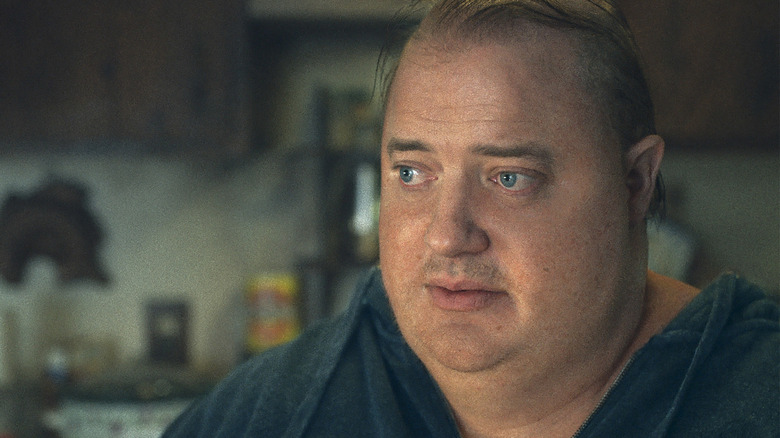
The 2023 Oscar nominations are finally here, full of surprises across the board, both positive (Andrea Riseborough! Brian Tyree Henry!) and unfortunate (where's the love for "RRR" or "Decision to Leave?"). Some truly excellent films received well-deserved and ample recognition, like the wonderfully ecstatic "Everything Everywhere All at Once" and the haunting "The Banshees of Inisherin." One not-so-surprising turn of events is the Best Actor nomination of Brendan Fraser in Darren Aronofsky's controversial entry "The Whale," based on the play by Samuel D. Hunter.
"The Whale" follows Charlie, a 600-pound English instructor with a good and vulnerable heart, who is literally eating himself to death following the tragic loss of his boyfriend and his estrangement from his furious daughter Ellie (Sadie Sink). The film sees Charlie routinely embarrassed, rejected, engaged in acts of clear self-hatred, and on the receiving end of a parade of hate speech over his weight in the film's lean but oh-so-long 117-minute runtime.
Key to Fraser's transformation into Charlie for the film is the use of an extensive set of prosthetics, often described as a 'fat suit,' as the foundation to build Fraser into Charlie's frame. For their efforts to make the body suit and makeup realistic, the makeup team behind "The Whale" earned the film's second and final Oscar nomination. Good intentions notwithstanding, Hollywood's history of using fat suits for comedy, drama, or otherwise needs to stop, and awarding a team for building one is, frankly, insulting. The Academy needs to do better and retire the fat suit entirely.
Hollywood's Obsession With Prosthetic Fatness
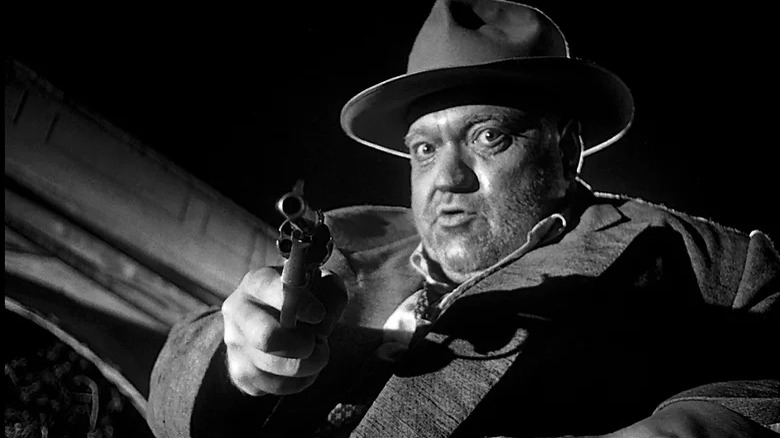
Hollywood has a long history of increasing actors' visible size to play the roles of larger human characters, for both dramatic and comedic intent. One traditional way is for actors to actually gain weight through dietary changes, like how Robert De Niro gained 60 lbs for "Raging Bull" or Christian Bale when gained over 40 lbs for both "American Hustle" and "Vice." The other route, often used to add even more dramatic amounts to the frames of actors, is to create large body suits to exemplify large, pregnant, or fat bodies ... and often for the purpose of ridicule, abuse, and so-called comedy.
Fat suits were worn by Orson Welles for dramatic effect in the 1958 noir "Touch of Evil," but their most infamous use is intended for either comedic effect or to showcase how far a character's fortunes have fallen. The former is shown time and again on numerous occasions, like 1996's "The Nutty Professor," the Austin Powers films, or to make jokes at young Monica's expense in "Friends." The latter can be seen in much of Thor's arc in "Avengers: Endgame," or the plight of all humanity in the background of "WALL-E," associating a rise in weight with a fall from grace.
In these films, a character's physical girth is too often treated with disrespect, as unattractive, or as a source of ridicule. Large characters are portrayed as buffoons, slobs, or with derision. Fat suits are frequently used in these stories to increase characters' weights beyond what diet and short time frames could do, often in productions that reduce characters to their weight or weight loss struggles, and in ways that typically reinforce these and other terrible stereotypes.
A Blunt Reproduction Of Tired Stereotypes
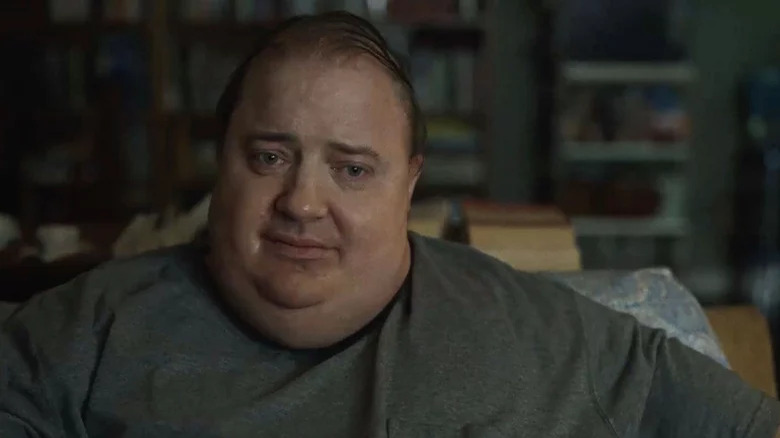
"The Whale" was intended to take on issues of eating disorders and extreme weight gain with empathy and sincerity, according to the creative team behind it. Samuel D. Hunter wrote the play inspired by personal experiences with weight gain and self-medication through food. Brendan Fraser certainly approaches Charlie with humanity and subtlety, fueled by his own history of struggles with weight gain and disordered eating. Prosthetics designer Adrien Morot used 3D printing technologies to make prosthetics that were "subtle and unnoticeable." Noble intent notwithstanding, "The Whale" isn't the film that can transcend this long history of Hollywood stereotypes.
Charlie is written as an amalgamation of myriad traditional stereotypes. Not just "morbidly obese," but a week from intentionally eating himself to death from self-hatred. Practically immobile, nearly every single aspect of his character centers around food, his size, or its consequences, from refusing to be on camera at work to having difficulties with masturbation. Fraser makes moments of nuance to this trope-consumed character as if by magic, but not enough to elevate the film when nearly every minute of the film subjects Charlie to a constant stream of self-hatred, embarrassment, or insults from other characters. These are compounded by directorial choices made to remind audiences that Charlie is only his weight, from horror music played over his eating to framing his attempts to stand in ways that emphasize his size instead of his humanity. "The Whale" doesn't transcend Hollywood's assorted pack of stereotypes, it purifies and concentrates them with the prosthetics-laden character in the center of it all.
We Should Be Done With The Hollywood Fat Suit
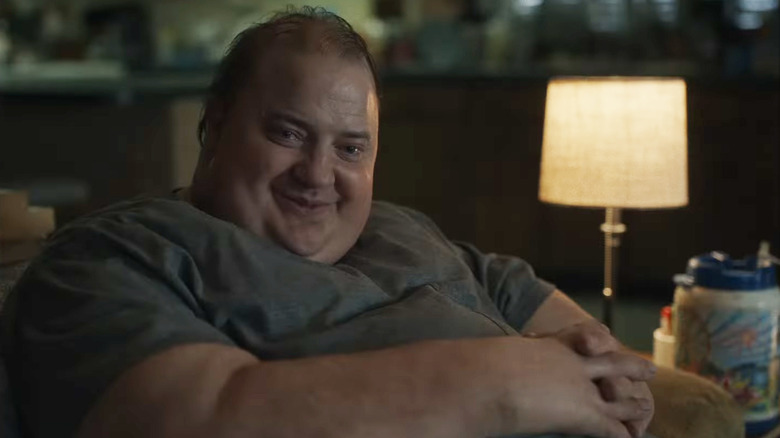
It's time to retire the fat suit forever, and especially time to jettison giving Oscar nominations to films for using a kind of prosthetic almost exclusively designed for stereotypical, reductive, and dehumanizing characterizations of people in larger bodies. Effects legend Rick Baker won an Academy Award for the slew of fat suits created for 1996's "The Nutty Professor." Nearly three decades later, one would expect the Academy to be more thoughtful around these issues, but better prosthetics are still locked into these same tired traditions — good intentions and talented designers notwithstanding.
People with larger bodies frankly deserve better than to see fat characters, characters who look like them or their loved ones, played for laughs or revulsion because of their weight, their body shape, or for simple acts like eating. No one should go to "Avengers: Endgame" and see the first MCU hero with their body type played for laughs, theaters becoming a cacophony of laughter and judgment. The answer isn't that we should have 'no more large characters,' but rather that we need better representation. Cast actors as rich characters whose arcs don't center on weight and food. Create more on-screen fat badasses and feature large characters with respect, power, and sex lives!
Most importantly, throw out the tradition of using fat suits to create yet another fat character whose on-screen purpose is to suffer weight-based self-hatred, embarrassment, and to be subject to abuse. Get rid of fat suits and certainly stop giving them Oscars.
Read this next: The Best Movies Of 2022
The post The Whale's Oscar Nomination for Makeup is Insulting, Frankly appeared first on /Film.
How Kurt Russell Ended Up As Elvis' Voice In Forrest Gump
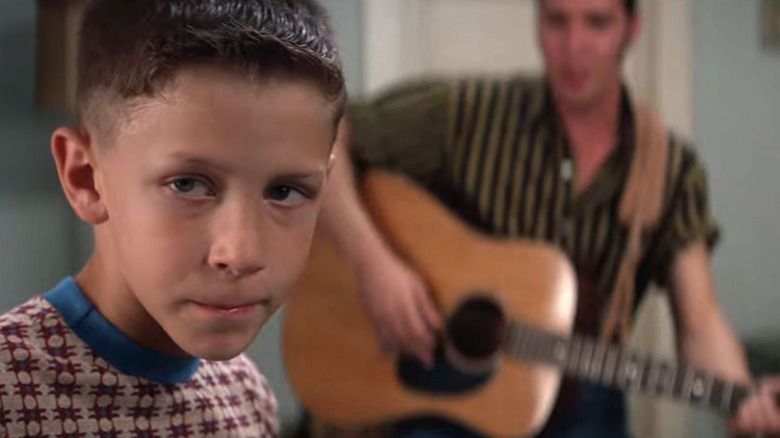
One of the reasons "Forrest Gump" is a cherished movie is because of the way it lightheartedly traverses decades of key moments in U.S. history and popular culture through the eyes of an altruistic titular protagonist, Forrest Gump (Tom Hanks) -- inspired by a couple of real-life blokes. In the eyes of the film, even one simple person can make a big impact on the world around them. The film cleverly blends these events with a fictional narrative to show the significance of Forrest's actions.
In "Forrest Gump," during Alabama Governor George Wallace's 1963 "Stand in the Schoolhouse Door" event where he protested the de-segregation of schools, Forrest curiously watches from the crowd and then helps African-American student Vivian Malone when she drops her books on her way into the school.
Later, during an appearance alongside John Lennon on "The Dick Cavett Show," Forrest inspires the lyrics to Lennon's best-selling single "Imagine." And he would visit John F. Kennedy at The White House just weeks before the President's assassination.
More humorously, the film posited that Forrest was the one responsible for calling security about the Watergate scandal, at Richard Nixon's doing. Forrest's mud-covered face is responsible for the smiley face logo all over t-shirts and stickers.
Oh, and in a chance encounter with Elvis Presley, Forrest taught the King of Rock and Roll how to dance -- how can we forget that. And even though we don't see him in "Forrest Gump," it was yet another opportunity for Kurt Russell to portray Elvis Presley on the big screen.
It Took Two Men To Play Elvis
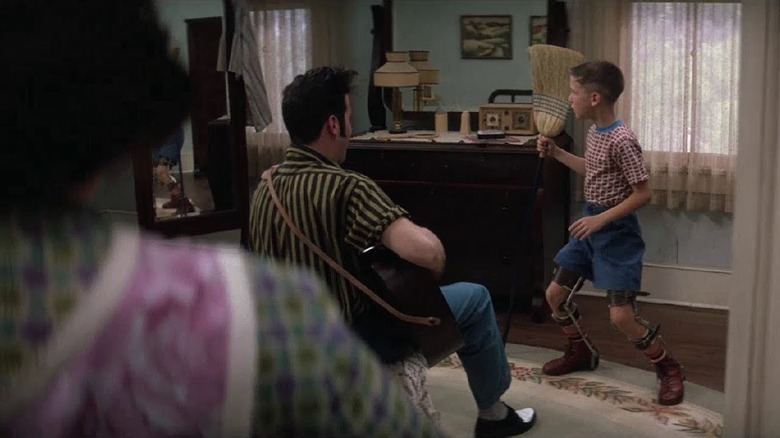
In the film's narrative, Forrest Gump (Michael Conner Humphreys) spent much of his early childhood in unwieldy leg braces as the result of a crooked spine. At one point, his mother Mrs. Gump (Sally Field) had taken to renting out rooms in their home for extra money. As Forrest would tell us, "There was always folks coming and going ... One time, a young man was staying with us, and he had [with] him a guitar case."
That young man, of course, was Elvis Presley. In the film, Elvis shows Forrest "a thing or two on the guitar." Because of his leg braces, Forrest could only dance by shaking his hips as best he could. After Elvis saw him dance, he asked Forrest to "show [him] that crazy little walk you did there." Forrest obliged while Elvis sang "Hound Dog." Director Robert Zemeckis cleverly hides Peter Dobson, who plays Elvis, either out of focus in the background or by filming him from behind.
It wasn't until years later that people would learn that Zemeckis hid Dobson from us in a totally different way. Although it was Dobson on screen as Elvis, audiences were hearing someone entirely different. Zemeckis even left Elvis' voice actor off the "Forrest Gump" credits. It was a secret that was kept hidden for decades.
Nobody Knew It Was Kurt Russell's Voice
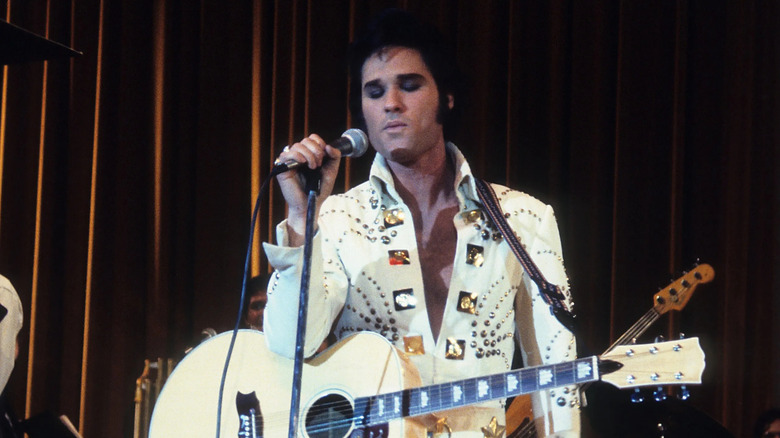
Kurt Russell's connection to Elvis Presley began tangibly. The "Escape from New York" star made his feature film debut -- albeit uncredited, just as with "Forrest Gump" -- in 1963's "It Happened at the World's Fair" starring none other than Elvis. And then in 1979, two years after Elvis's death, Russell portrayed the musical icon in John Carpenter's made-for-TV movie, "Elvis."
But there's a lesser-known Elvis appearance — if you can even call it that — in Russell's filmography: "Forrest Gump." The Elvis in the Tom Hanks-led film is an amalgamation of Dobson (providing the body) and Russell (offering the voice).
While Russell's involvement had long been a rumor, the actor finally confirmed it in a 2016 interview with GQ. And much like Elvis steals Forrest's dance moves in "Forrest Gump," Russell sort of stole the voice from Dobson:
"I did that as a thing for [director Robert Zemeckis]. He didn't like what it was and said, 'I need something real bad.' I didn't know if, to be honest with you, [Zemeckis] was doing it on the sly. In other words, the actor didn't know. It was fun to do."
Though it wasn't planned, his performance as Elvis in "Forrest Gump" continues to make Russell one of the most convincing Elvis actors in Hollywood. Even when we don't know about it.
Read this next: 14 Remakes That Are Better Than The Original
The post How Kurt Russell Ended Up As Elvis' Voice In Forrest Gump appeared first on /Film.
Rome Showrunner Bruno Heller Never Thought HBO Would Actually Make The Series
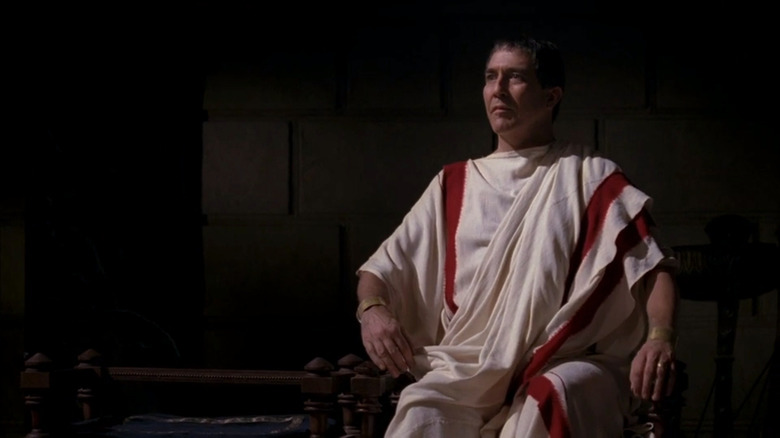
The arrival of "Rome" in 2005 marked one of the most expensive productions of all time for its co-producers HBO and BBC. Its makers had grand plans. Set in the first century BCE, "Rome" would chart Ancient Rome's transition from being a republic to an empire -- while taking us through the assassination of Julius Caesar, and the deaths of Mark Antony and Cleopatra. But the show lasted for two seasons out of a planned five, with about three seasons of story shoved into the second (and final) season. The reason? I've already brought it up -- the budget.
The first season of "Rome" cost upwards of $100 million. That's about $8 million per episode. A lot of that money went toward the incredible sets and the amazing costumes. "Rome" showrunner Bruno Heller ("Gotham," "The Mentalist"), who had the task of planning out the five seasons, told Den of Geek in late 2020 that he was actually "cheap" for a writer as he was new then. What Heller is most surprised about is that the series ever got made.
'Very Unlikely To Be Made'
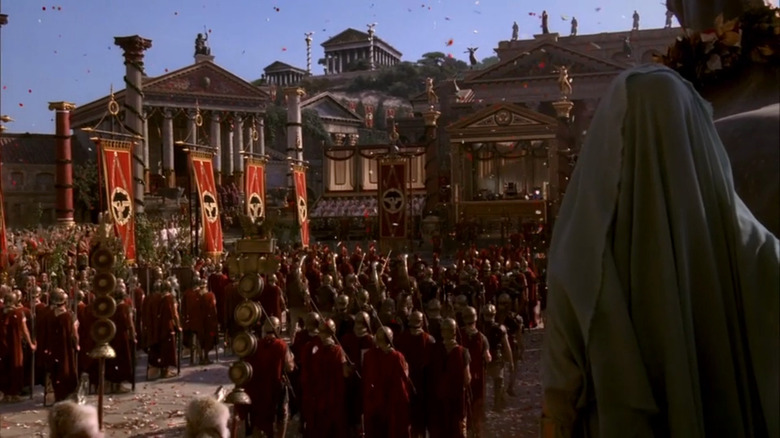
Producing a series on the scale of "Rome" is an incredible undertaking. For one, it was shot in the Italian capital. On top of that, they wanted to create something closer to what a bustling city of that time would have been like. Remember, this is the first century BCE -- so it's dirty, smelly, and very crowded. Bruno Heller told Den of Geek: "[Luckily,] every previous representation of Rome on any scale kind of went for the grand imperial late Edward Gibbon velvet drapes and marble columns. Even 'Gladiator' went for that. Whereas, in fact, it looked much more like Calcutta or Bombay and smelled like that."
Given all these challenges, Heller thought there was no way anyone could afford to make the series:
"It's one of those projects that's really going for broke and very unlikely to be made, [given] the budget that was required. They were paying me to write a script to take it at least to a respectable point at which time they can say, 'Okay, thank you.'"
Figuring out the series' roadmap, Heller added, was equivalent to "planning for a war, for a campaign. It's [like] invading Russia." Watching the series, which I've done several times now, you very much get the sense of what it was like. And in contrast to some of its big-budgeted successors, "Rome" gave us a look at what it was like for the working classes and the soldiers who weren't at the top of the food chain.
More About The Psychology Than The History
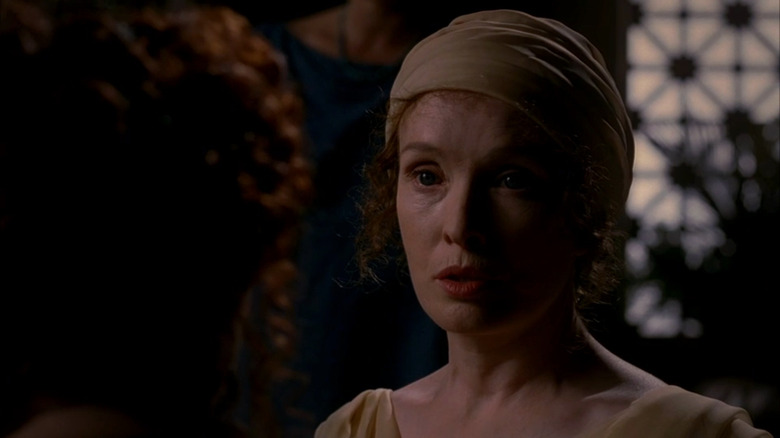
Despite how deep the research and the historical accuracy went, "Rome" wasn't trying to say that this is precisely what each character said in each moment. Ahead of the second season, Bruno Heller said in an article on HBO in 2007:
"We try to balance between what people expect from previous portrayals and a naturalistic approach ... This series is much more about how the psychology of the characters affects history than simply following the history as we know it."
As a fan, I can say that "Rome" gave me a deeper understanding of the time period than any book ever has. As a history buff, it also made me feel like I was right there in the middle of it all. I remember going to visit Rome in person and then firing up HBO for a rewatch once I was back home. Not for a single moment did it fail to live up to that first viewing -- and it even provided context to my trip.
Unfortunately, in an era prior to "House of the Dragon" and "The Lord of the Rings: The Rings of Power," BBC found "Rome" too expensive to commit to all five seasons. With the co-producer out, HBO decided that season two would be its last. The final season was indeed overstuffed -- and yet, it was utterly compelling.
Say what you like about giant budgets and whether or not a TV show should have them, "Rome" is a standout when held up to some of the top series. Even almost 20 years later, I feel a deep sadness that we didn't get the planned five seasons (and the talked about "Rome" movie that will never happen). Still, it was the gateway to big-budget prestige TV -- "Game of Thrones" followed a few years later, kick-starting a whole new era -- and I'm grateful for that.
Read this next: Shows Like Game Of Thrones You Definitely Need To See
The post Rome Showrunner Bruno Heller Never Thought HBO Would Actually Make the Series appeared first on /Film.
Steven Spielberg Thinks Adult Dramas Will Make A Comeback At The Box Office
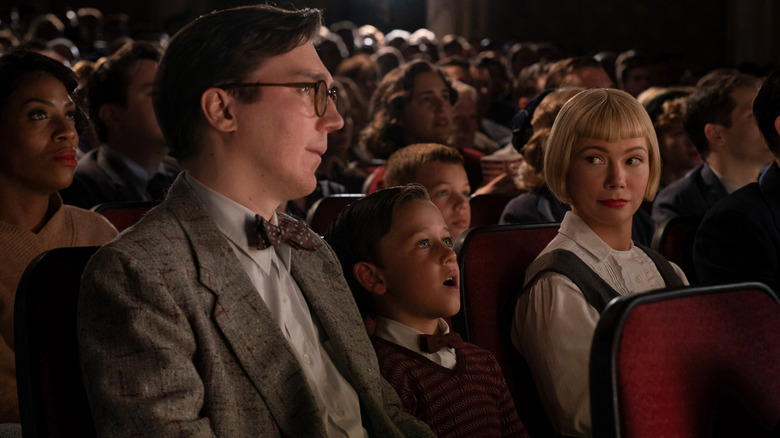
It's the million dollar question of our current box office landscape: Can mid-budget, adult-oriented dramas -- once thought to be the consistent, moneymaking lifeblood of the industry -- ever make a genuine comeback? Movie theaters are all but littered with the remains of countless films that never even stood a chance of turning a profit in recent years (/Film's own Ryan Scott has reported on 2023's first disappointing performance of that nature, the Hugh Jackman-starring "The Son"). The reasons for this trend are far more nuanced than it might seem at first blush, having to do with any number of factors ranging from the ever-changing tastes of moviegoers in general, the rising prevalence of streaming-exclusive releases, studios conditioning audiences to only turn out for the biggest blockbusters, the cost of ticket prices, and, of course, the ongoing pandemic.
Whatever the case may be, however, the end result is still the same: While $200+ million blockbusters, horror films, and other genre fare continue to flourish on the big screen, the relatively more humble offerings of original, star-driven, and adult-skewing pictures that used to thrive alongside those types of movies are no longer a sure bet.
So who else but Steven Spielberg to wade into this discussion and offer up some words of wisdom? Sure, the director who pioneered the very concept of the summer blockbuster with "Jaws" and "Jurassic Park" can't exactly wag his fingers at audiences for simply following his influence. But having seen recent efforts such as last year's "West Side Story" remake and even "The Fabelmans" struggle to find their footing in theaters, perhaps he's best positioned to analyze the future of such movies. Somewhat surprisingly, his ultimate conclusion is filled with nothing but optimism.
Reason For Hope?
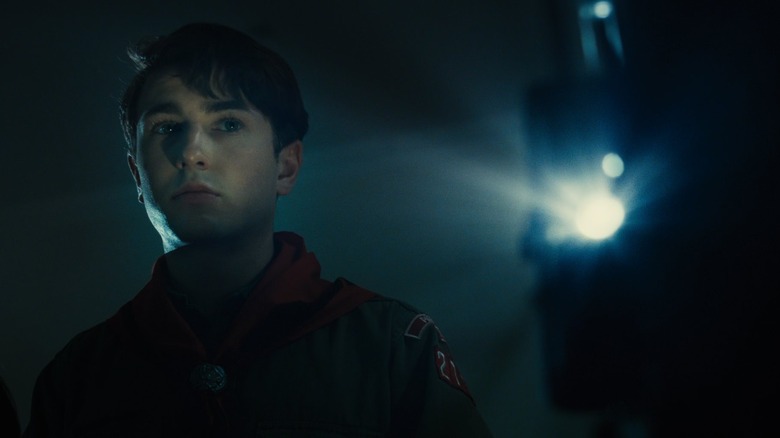
Steven Spielberg has seen it all. The days when movies like "Close Encounters," "Schindler's List," and even "A.I. Artificial Intelligence" could earn upwards of hundreds of millions of dollars might seem like a distant memory to the likes of you and me. But, remember, it wasn't even that long ago when historical epics like "Lincoln" could gross almost $300 million worldwide. The widely-proclaimed "death" of adult dramas would seem to be a very recent phenomenon.
But that doesn't mean the greatest filmmaker of our time sees no light at the end of the tunnel. In an interview with Deadline, Spielberg offered up some reason to hope.
Referring specifically to the theatrical marketplace, he said, "I think it will come back, but it's coming back slowly, especially for dramas." It's possible we're already seeing the very beginnings of this, as this year's crop of Best Picture nominees happen to be made up of quite a few breakthrough successes. But as for reasons why we've found ourselves in such a precarious place, Spielberg pointed the blame squarely at COVID. "I think the pandemic really encouraged a lot of audiences, not just middle-aged audiences, but younger, to stay at home and watch on the medium screens in their houses." But even while acknowledging the reality of life post-2020, Spielberg noted that:
"We have a social need to be together in the world, I don't think that will be stopped by a pandemic. It can be frustrated by the pandemic, but eventually we'll see more adult films doing decent numbers in movie theaters."
"Decent numbers" might not be the most ringing endorsement, mind you, but it's better than nothing! For those willing and able, it's rarely felt more important to support the art we love on the big screen.
Read this next: 12 Best Performances In Steven Spielberg Movies
The post Steven Spielberg Thinks Adult Dramas Will Make a Comeback at the Box Office appeared first on /Film.
Poker Face Review: Natasha Lyonne Is A Modern-Day Columbo In Rian Johnson's Delightful Mystery-Of-The-Week Show

There's something cozy about "Columbo," which is an interesting angle since it's a show about murder. But watching Peter Falk's rumpled detective get the drop on smug killers who think they've gotten away with the perfect crime is both comforting and charming; it's hard not to have fun.
"Poker Face," the new Peacock series created by Rian Johnson, is gunning to be the "Columbo" heir-apparent, resulting in a warm, funny, and cozy series that, like "Columbo," is all about murder. Johnson has become renowned for his whodunits in the forms of "Knives Out" and the more recent "Glass Onion," but like "Columbo" before it, "Poker Face" is not a whodunit. Instead, it's what is traditionally known as a "howcatchem" — we already know who committed the crime. The mystery is in how the crime ends up solved.
Like "Columbo," "Poker Face" has a rumpled, laid-back, amusing protagonist — Charlie, played with a certain Falkishness by Natasha Lyonne. Lyonne, with her very distinct way of speaking and overall cool demeanor, is always fun to watch. I don't know if I'd say she has a wide range of parts she can play, but Lyonne is very good at playing a particular type of character, and that's what she gets to do here.
Unlike Columbo, though, Charlie isn't a cop. She's not even really a detective. But she does possess a unique gift: she can always tell when people are lying, like a human lie detector. Charlie can't quite explain how her gift works. It's just a certain feeling she gets when talking to people. Whenever she's speaking with someone — even someone she just met — she can always, and I mean always, tell when they're bending the truth. As you might imagine, such an ability can come in handy when murder is involved.
Crime Of The Week

"Poker Face" arose from Johnson and Lyonne's shared love of detective stories — and old TV. "I'd been thinking about the types of TV that I grew up watching as a kid like 'Magnum P.I.,' or 'Murder, She Wrote,' or 'The A-Team,' or 'Quantum Leap' and how fun it could be to do a crime-of-the-week show like that with the strangeness and the style that I like to use in movies," Johnson said.
The end result definitely feels like a cozy throwback to those classic shows — while still feeling modern, but not too modern. Unlike Johnson's "Knives Out" films, "Poker Face" doesn't date itself with uber-current cultural references. Instead, it's willing to coast on both its tales of crimes — and its highly likable lead. This gives the show an overall throwback feel that makes the entire experience all the more enjoyable.
"I loved the idea of doing a series with a complete story in each episode that had a continuous character you could count on being there," Johnson said. "But the reality is, if you look at any of those shows, they're all built around a charismatic lead who can hold the screen not just as a movie star, but as a personality you want to hang out with every week and watch win."
With her gruff voice, thrift-store chic attire, and laissez-faire attitude, Lyonne's Charlie becomes our easy-to-love hero, stumbling into one murder after another. After a premiere episode that establishes who Charlie is and what she does, the character hits the road. She has a reason to be on the road — she's on the run from some shady criminals. Charlie's nomadic nature allows her to move from one town to the next, and wherever she goes, murder awaits.
In true "Columbo" fashion, each episode of "Poker Face" begins without Charlie. Instead, we're introduced to a character who will die before the prologue ends and a character who will kill them. The crimes range from genuinely disturbing to comical, and nothing is ever as it seems.
After we're introduced to the crime at hand, episodes of "Poker Face" then jump back in time to show us how it all started. And along the way we learn that Charlie was hanging out in the background all along, waiting to be drawn into the mystery via her propensity for sniffing out a lie.
Addictive, Episodic TV
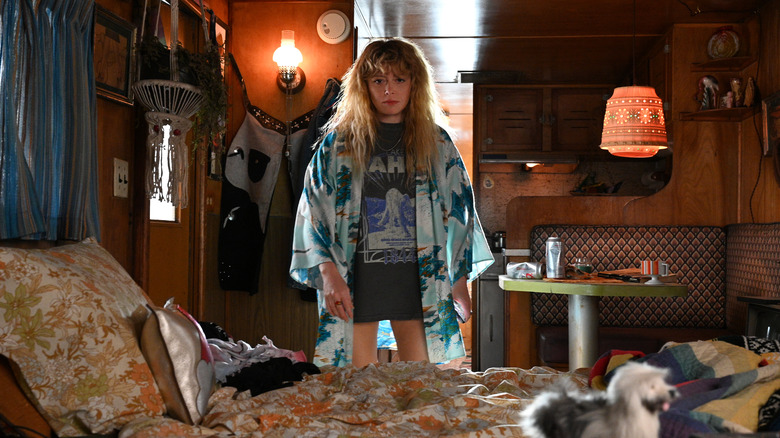
While the overarching story of Charlie's life on the lam hovers over the show, each episode of "Poker Face" is self-contained, and that makes the series all the more rewarding. You don't need to enter the show with baggage. You don't have to bone up on source material and do homework to make sure you understand everything going on. You just need to know the basic premise — Charlie can tell when characters are lying! — and go from there.
The crime-of-the-week format allows for plenty of guest stars (and guest criminals), including Adrien Brody, Chloë Sevigny, Ellen Barkin, Hong Chau, Jameela Jamil, Stephanie Hsu, Tim Meadows, and many more. But it's Lyonne's amateur sleuth that keeps things centered and moving. The format of each episode also grips us — we start with the murder and then have to work backward to figure out how it all really went down. The format proves addictive — I kept telling myself, "Okay, I'll stop after this episode," only to then immediately want to watch the following episode to give me my crime-of-the-week fix.
Of course, how I watch the show and how you watch the show is bound to be different since I was provided with screeners (I've seen six episodes of the 10-episode first season). The episodic nature of "Poker Face" is the antithesis of the binge-watching model, and indeed, the series will be released weekly (after the first four episodes drop at once, that is). My suggestion, dear reader, is for you to savor "Poker Face." Embrace the mystery-of-the-week nature of the show and travel along with Charlie as she gets mixed up in one murder after another. You may think you have the mystery solved, but you're not a human lie detector. There's always one more rock to overturn and one more discovery to be made.
"Poker Face" premieres January 26, 2023, on Peacock with 4 episodes at launch, followed by a new episode streaming Thursdays.
Read this next: The 18 Best Crime Dramas In TV History
The post Poker Face Review: Natasha Lyonne is a Modern-Day Columbo in Rian Johnson's Delightful Mystery-Of-The-Week Show appeared first on /Film.
Allison Williams Channeled Elements Of Her Girls Character For Jordan Peele's Get Out

Lena Dunham's "Girls" is the kind of show you either really love or really hate. Meant to capture a specific moment in time, the HBO-produced series follows a group of four young millennial women living in New York City as they try to navigate the trials and tribulations of adulthood. What sounds like a fairly average premise actually became a culture phenomenon thanks to Dunham's so-insufferable-that-she's-maybe-lovable character Hannah Horvath and her group of equally lost and disenfranchised friends. Along with Dunham in the lead role, the show stars Adam Driver (before he became a Hollywood staple) as Hannah's on-again-off-again, definitely abusive boyfriend, and Jemima Kirke, Zosia Mamet, and Allison Williams as Hannah's friends.
On the show, Williams plays Hannah's best friend Marnie Michaels. Out of the two of them, Marnie is the one who seemingly has her life together, but as the series unfolds, it's clear that Marnie is just as adrift as the rest of them. Her opinionated and controlling behavior often give way to a deep need to appear as the considerate, put-together friend in the group. However, her eagerness to help is often tinged with her own narcissism. When she eventually marries her music partner Desi Haperin (Ebon Moss-Bachrach before the Italian beef shop), she's finally forced to reckon with her own demons.
Since "Girls," Williams has appeared in a handful of horror films ("M3GAN" fans, unite!), the most notable being Jordan Peele's 2017 "Get Out" in which she played the manipulative (I.E. racist) Rose Armitage. On the surface, Williams' characters in these two projects seemingly have nothing in common, but if you take a closer look, Marnie and Rose are actually a lot alike. In fact, Williams has stated that her part on "Girls" really helped in developing her character in "Get Out."
Two Of A Kind
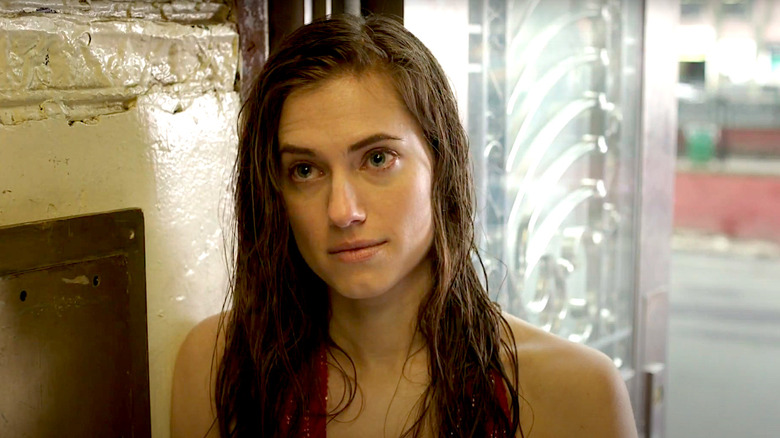
Marnie Michaels is the perfect example of a privileged, young white woman who lacks the self-awareness needed to understand when it is and is not appropriate to offer her opinion. Throughout "Girls," she constantly attempts to mother her friends, however, her need to always be right often casts her in a comical, cringey light. If "Girls" were to air today, Marnie would definitely be the highly woke white woman with a bad habit of virtue-signaling online without ever really doing anything to create positive change.
Many of Marnie's traits are similar to Rose Armitage in "Get Out." Like Marnie, Rose operates under a false veneer of self-awareness, reassuring her boyfriend Chris (Daniel Kaluuya) that her family will not care that he's Black. However, as fans of the film know, Rose is actually pretty racist (to a terrifying degree), helping her parents capture and enslave Black people through manipulation and mind control.
In a recent interview for The Guardian, Williams talked about how she channeled parts of her "Girls" character for her role in "Get Out." After explaining how many people thought Williams was actually like Marnie in real life, she says, "I learned that this element of Marnie-ness that I was having so much trouble shaking was something that I could actually use and weaponise and have fun with." So she took that "Marnie-ness" and used it to develop Rose. "It was so cathartic after years of people being like, that's who you are, that's who you are, that's who you are, I was like OK, you know who else that is? That could also be the most evil person that's ever lived," she says.
On the surface, "Girls" may not be a horror show, but its narcissistic characters certainly make for great horror inspiration.
Read this next: The Highest Rated Horror Movies Of All Time
The post Allison Williams Channeled Elements of Her Girls Character For Jordan Peele's Get Out appeared first on /Film.
Jeff Goldblum Developed A Detailed Backstory For His Independence Day Character
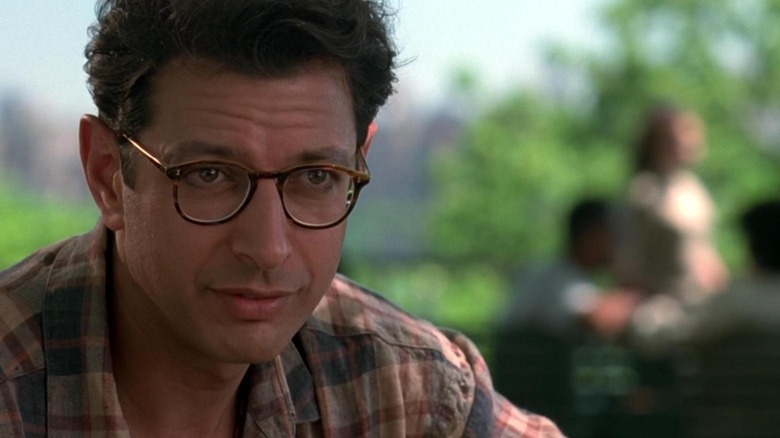
It's not an uncommon practice for actors to create backstories for their characters. Viola Davis, for instance, has said she always writes a biography after reading the script. Before filming "Harry Potter and the Prisoner of Azkaban," director Alfonso Cuarón had Daniel Radcliffe, Emma Watson, and Rupert Grint write essays about their characters -- with Grint ignoring the assignment, because he figured that's what Ron Weasley would have done. Being an old pro in the business, it shouldn't come as a surprise to learn that Jeff Goldblum takes a similar approach when creating a character.
Not every character is going to have a detailed history when it comes to the script, after all. And unlike the "Potter" actors, you're not always going to have thousands of pages of books to comb through to help you along the way. This is particularly true of a movie like "Independence Day," which wasn't adapted from any pre-existing works and was more focused on the spectacle than forming fully fleshed out characters. People bought tickets to see the aliens, the action, and the explosions, and not to learn how Will Smith and Vivica A. Fox's characters met.
But not having much to work with was never a problem for Goldblum. Being a famously colorful and larger than life personality in his own right, it didn't take much for him to create a detailed, intricate, and -- in true Goldblum fashion -- predictably bizarre history for his genius character David Levinson.
An Eccentric Backstory From An Eccentric Actor
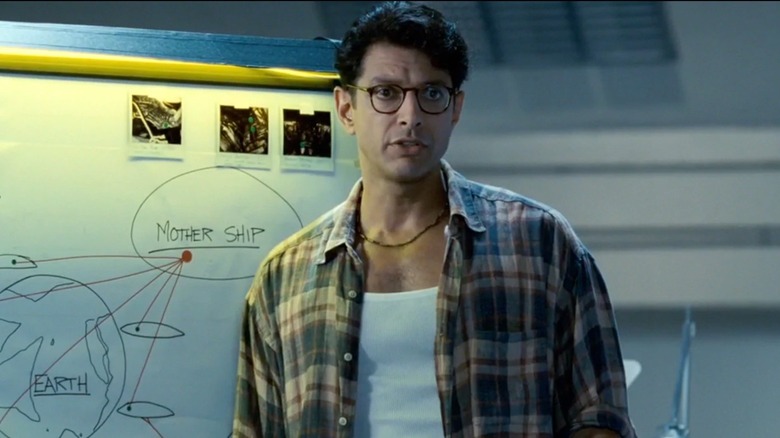
Given that Jeff Goldblum has arguably become more fascinating to his fans than the characters he plays (to the point where he has a show in which he travels around being simply dazzled and delighted by, well, pretty much everything), his backstory for David is probably on par with what you might expect: weird, unnecessarily complex, and bafflingly dark. In his mind, David's father had been a World War II veteran who had later sent him to martial arts training. As Goldblum expanded to GQ in 2016:
"I think I had an athletic and multifaceted capacity for that. And I became very, very, very good. Dangerous, even. I ascended very quickly, along with becoming a piano player and a techno kind of student and master in some ways, until one day something happened in school. A big bully, a troublesome guy, was giving a hard time to somebody. Something unexpectedly emotional and passionate rose up in me. And I put him in the hospital. He almost died."
Now, whether any of that -- outside of being technologically savvy -- registers on screen is up for individual interpretation. Obviously, David is a tech expert and almost singlehandedly solves the problem of how to defeat the alien invaders in the film. That said, given he was also apparently secretly a martial arts master, would it have killed "Independence Day" director Roland Emmerich to give him one little scene showcasing the ways in which his fists are E.T.'s worst nightmare?
Read this next: Sci-Fi Movies That Accurately Predicted The Future
The post Jeff Goldblum Developed A Detailed Backstory For His Independence Day Character appeared first on /Film.
Mass Effect 3 Unofficial Patch 2022 is a must-have mod for the original 2012 version
Modder ‘Orikon’ has released a brand new version of the Unofficial Patch Project for the original Mass Effect 3 game. As said, this patch is for the original game that came out in 2012, and not for the remastered version that is available in Mass Effect Legendary Edition. This Unofficial Mass Effect 3 Patch (UME3P) … Continue reading Mass Effect 3 Unofficial Patch 2022 is a must-have mod for the original 2012 version →
The post Mass Effect 3 Unofficial Patch 2022 is a must-have mod for the original 2012 version appeared first on DSOGaming.
LastPass Parent Company GoTo Suffers Data Breach, Customers' Backups Compromised
Metro Exodus SDK Released, Next Metro Influenced by Ukrainian Creators’ War Experiences

The Russian invasion of Ukraine has had a profound effect on the country’s burgeoning video game development community, with few more deeply affected than Metro franchise creators 4A Games. While the company is now officially headquartered in Malta, many of the studio’s employees remain in Kyiv or elsewhere in Ukraine. In a new blog post, 4A provides details of the daily hardships and stress the team faces as they continue to try to operate within a warzone. Despite the challenges, work still continues on 4A Games’ next projects, including a new Metro title.
“For our Kyiv studio and Ukraine-based personnel, it’s now being made under the most extraordinary and horrifying of circumstances. Some days start with our morning stand-ups and a coffee. But some start with air-raid sirens and missile strikes. Some days we take the Metro to work but other days we’re forced to shelter in it. Each day we try and live our lives with as much normality as we can muster, and yet we’re dealing with power and water cuts, families who need re-locating, friends and colleagues volunteering or being called to the front. Our “new” normal… it isn’t normal, by any stretch of imagination. It’s life during wartime, and it inevitably shapes the games we make.”
While the circumstances surrounding the development of the next Metro game are unfortunate, 4A Games promises they’re using the inspiration to make a stronger, better game.
“The next Metro game is also changing for the better. And not simply because of the circumstances we find ourselves in. We’ve never hidden the fact that the Metro series has always carried a strong political and anti-war message. Yes, we’ve always wanted to entertain and immerse you in our post-apocalyptic world but there’s also been a bigger story to tell. And the war in Ukraine has made us re-think what kind of story the next Metro should be about. All the themes of Metro – conflict, power, politics, tyranny, repression – are now part of our daily-life experiences. So, we’re embracing them and weaving them into the game with a renewed purpose.”
Of course, given the situation in Ukraine, it may be some time before the next Metro arrives. In the meantime, 4A Games is releasing the Metro Exodus software development kit for free to anybody who owns the game on PC. These aren’t mere “mod tools,” but rather the full editor 4A used to make the game. Here are some of the features included…

- Scene Editor - The Scene Editor is the tool you use while working on a level. It is mainly used for adding and manipulating all kinds of objects, from NPCs and weapons to patrol points, restrictors, and proxies.
- Model Editor/Viewer - The Model Editor allows you to change collision properties, textures, materials, add locators and texture presets, edit animation tags and other animation properties.
- Navigation - The Navigation Mode allows you to create/edit the navigation mesh (aka: AI map) of the level. This is required for the AI (enemies, friends, etc.) to move through the level.
- Particles - The Particles Mode allows you to create/edit particles in the game.
- Terrain Tool - The Terrain Tool allows you to edit terrain for your level. Valleys, mountains, caves, uneven or sloped ground, etc. You can easily modify both shape and appearance by using a range of tools.
- Weather Editor - The Weather Editor allows you to create weather presets to use within weather volumes. There are several options to adjust: Skybox, Sun, Clouds to Post Process, Snow/Water Levels, etc. You can create different types of weather, Day/Night Cycles, or Modifiers.
- Camera Track Editor - The Track Editor is used for creating cutscenes, camera spans, camera shakes, and screen effects.
- Visual Script - The VS (Visual Script) Editor allows scripting complex gameplay features and AI behavior without writing a single line of code. The main advantages of visual scripts include their simplicity and clear visual feedback to the user. Their logic is founded upon so-called events which are produced in the scripts by specific triggers, and further processing of these events.
Metro Exodus is available on PC, Xbox One, Xbox Series X/S, PS4, and PS5, although obviously, the mod tools are only available on PC.
We here at Wccftech hope for a resolution to the conflict and the safety of all Ukrainian citizens. If you wish to donate to the International Committee of the Red Cross to support humanitarian efforts in Ukraine, head to this page.
The post Metro Exodus SDK Released, Next Metro Influenced by Ukrainian Creators’ War Experiences by Nathan Birch appeared first on Wccftech.
Infinite Inboxes of Infinity
Carcinization is the tendency of reality to keep making things into Crabs or Crab-like creatures. (De-Carcinization is when it goes the other way, and in fact there’s evidence of oscillation between the two states.) It’s the sort of thing that sounds fantastically interesting, the shallow end of the thinking pool, but then leaves you confused as to what to do with that information – you can’t fully stop it, and there’s no reason you might specifically want to. And whatever crab-making is happening now doesn’t really affect you in the short or even long-term – it’s just happening.
What I discovered, this late in life, is I turn everything into an inbox. Again, I’m not sure this is going to change your existence or opinion in any way, but here we are.
In the dim mists of decades ago, I appear to have launched into a serialization of projects that I’ve never recovered from, making piles of to-dos and tasks and then attacking them, often at the expense of all else, for hours and hours. The earliest efforts of what became TEXTFILES.COM was me gathering textfiles from all sorts of bulletin board systems, logging in to grab copies and take text-based snapshots of what was there, then dragging it home into piles of floppy disks, with the goal of…. well, something. I started calling the disks “The Works, Disk _____” as I visualized, at 13, that I would one day have a BBS called The Works and these disks would be the starting seed vault that it would grow from. The fact this happened is quite remarkable to me, but it happened. The Works BBS under Jason became the Works BBS under David and then Matt and then Others, and I then took the textfiles of The Works BBS and it became a site, itself a collection of descriptions that came because I created a second Inbox, one of describing roughly 50,000 files by myself.
That all seems like a rather straightforward observation, except it turns out that nearly everything I am doing, in all situations, has become an inbox, a collection of waiting piles of transferred or fetched tasks that require some sort of response, acknowledgement, or process as a result.
All this to say, that’s why this weblog hasn’t seen a real update in years.
The dark side of a Life of Inbox is that if some inboxes are more pressing or easier to process, other inboxes fall by the wayside, because they either require Deep Thought or otherwise need my full attention, and my full attention has become a rare commodity indeed.
I started this site for, essentially, Essays. Thoughts that would be best explained in detail, and then referenced over time, where people could pick them apart or talk about them, or be able to explain my motivations or efforts in a laid-back, slow-cooked, contemplative fashion instead of the hottest bon mot to fly out of my keyboard. And for years, it was definitely that.
Two things took that away.
First, the Podcast turned into a receptacle for both my essays, and presentations I might give; 12-20 minute compositions about subjects I thought needed covering, offered in a way that both reached people, and allowed, through a Patreon, to help cover my debts and money issues over the years. For both those situations, it has been a runaway success – my debts are basically paid (although I do get costs like medical that crop up, and taxes still continue to be a bother), and I’m happy with the subjects I’ve dove into across over 200 episodes, which is a lot of episodes to be sure.
Second, social media is a very nice way to construct a simple outlook, a shallow formed snowball from some half-cooked ideals, and throw them into the public sphere. And that’s been fascinating in its own right, and led to crushing lows and exhilarating highs. I’ve been lambasted, treated like royalty, and made amazing connections via the various to-the-minute inboxes they represent.
But with the very real, very actual spiral of Twitter, one of my inboxes has cleared up with a puff of poorly-administrated smoke. Because of architectural changes, I’m no longer getting what the folks call “engagement” in a meaningful way, and Mastodon, where I find myself living as well, does not encourage the multiple-dives-a-day energy of Twitter (for the better of all, to be honest).
So, back comes this weblog, with the 2020s in full swing and the world grinding along, and it’s nice to be back. I try not to cover old ground unless it’s needed, so the Rule of Essays continues.
Let’s go.
Shooting Grumpy Old Men On Location Was Especially Punishing For Walter Matthau
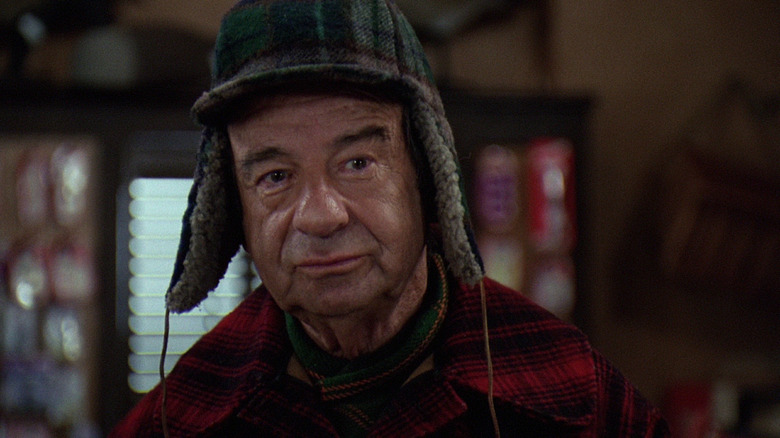
Growing up in Philadelphia, I've experienced my fair share of harsh winters. The blizzard of 1996 stands out, but there were a number of other rough years for a while too. Although, when I moved to Chicago a few years ago, I experienced a whole new level of frigid chills. It got even worse when a polar vortex delivered such sub-zero temperatures and precipitation that people were advised not to leave their houses since even the slightest bit of exposed skin could get frostbite within minutes. Seriously, despite this year being relatively tame in comparison (so far, though I probably just jinxed it), midwestern winters are no joke. And someone else who knew this was Walter Matthau.
By the mid-1990s, the award-winning star of the stage and screen had quite an illustrious career. He had become known for his roles in "Bad News Bears," "King Creole," and "Hello, Dolly!," but fans probably remembered him best from his many onscreen collaborations with Jack Lemmon including "The Fortune Cookie," "The Front Page," and, of course, "The Odd Couple." So when the duo was brought back together for 1993's "Grumpy Old Men," fans were excited to see Matthau and Lemmon together again. However, even though he looked forward to teaming up once again after about a decade, Matthau was less than pleased that their reunion would have to take place in Minnesota during the peak of winter.
Cold Enough For Ya?
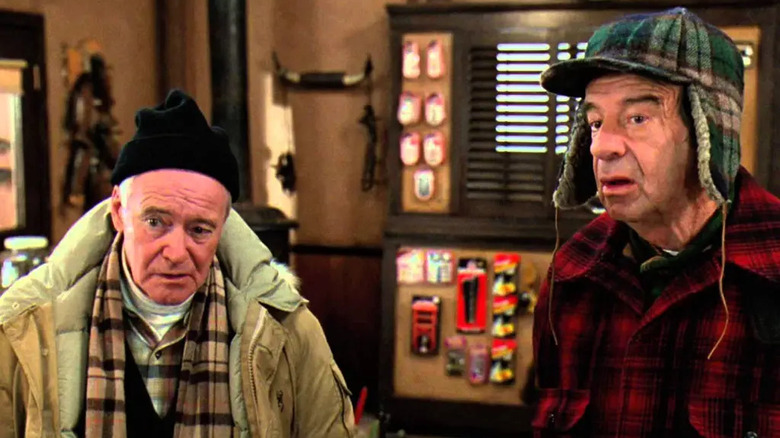
In an interview with legendary film critic Roger Ebert to promote "Grumpy Old Men," Walter Matthau spoke a great deal about gambling. And though he would be open to gamble on just about anything, he and Jack Lemmon didn't take such chances with their careers and the projects they did together. After "Buddy Buddy" flopped in 1981, they didn't properly share the screen again until this project came along around 10 years later.
While they had been offered a number of scripts in between, none of them seemed like the right fit until producer John Davis brought them Mark Steven Johnson's tale about two crotchety neighbors competing for the affection of a new woman in town. And even though Matthau was ecstatic to reunite with his friend, he resisted the film's midwestern setting and attempted to change it. Here's what he said:
"The only reason I did the movie was to work with Lemmon. [...] Now, the only thing was I didn't want to go to Minnesota in the middle of January, so I said to Lemmon, 'Listen, Lemmon, we have to fix this script up a little so let's rewrite it, and then we'll say OK.' But, I said, 'Maybe we can do this in Hawaii or Florida because one of us is not coming back if we go to Minnesota.' Because in Minnesota it gets so cold that the body wishes to retain the heat; otherwise, you die. In order to retain the heat, the coronary arteries are immediately constricted for retention of heat and as soon as you restrict the coronary arteries, you're subject to a heart attack; you're subject to a stroke; you're subject to double pneumonia. I got all of them."
A Slip Of The Tongue
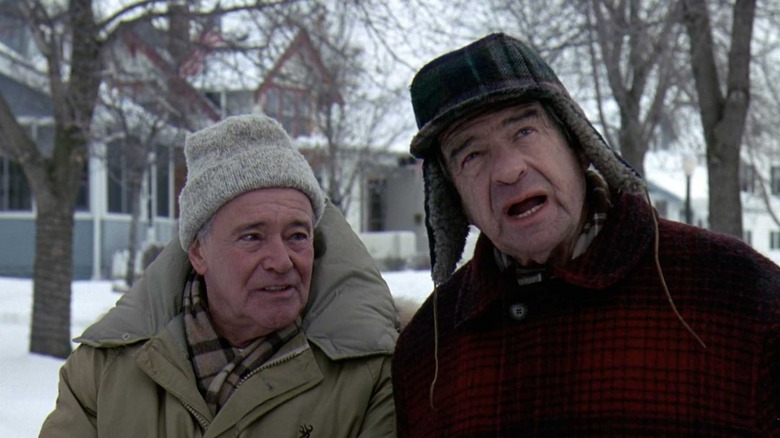
Luckily, both men survived the production and ultimately went on to make four more movies together, including a sequel titled "Grumpier Old Men," as well as a sequel to "The Odd Couple" that saw Oscar and Felix take a cross-country trip in order to see their children get married. But as the actor previously mentioned, they didn't escape Minnesota completely unscathed. In addition to all of Matthau's ailments, he described a situation where his co-star's tongue had gotten stuck to his gums.
"Lemmon, nothing happened to him at all. Just once. I stopped the shooting and I went over to the producer and I said, 'Better get him to a hospital; something's wrong with him.' His tongue — it was so cold, it was 40 below zero without the wind-chill factor — his tongue had stuck to his gums. That's how cold it was."
Eat your heart out, "A Christmas Story!" And yet after things like that, people still decide to live here. On purpose.
Yeah, I don't get it either.
Read this next: The 15 Best '90s Comedies Ranked
The post Shooting Grumpy Old Men On Location Was Especially Punishing For Walter Matthau appeared first on /Film.








